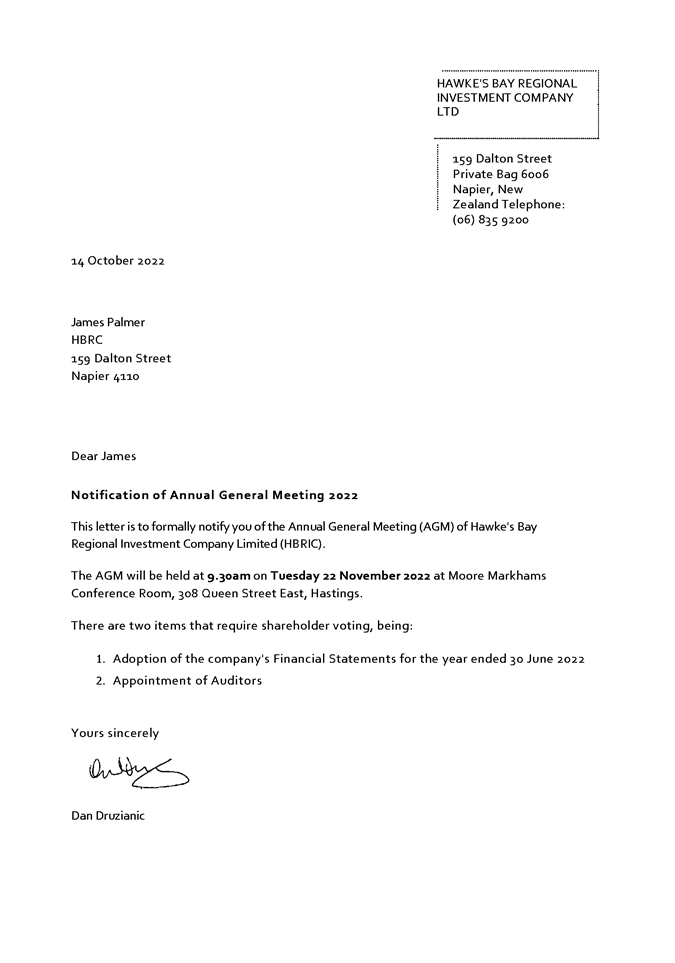Meeting of the
Hawke's Bay Regional Council
Date: 16 November 2022
Time: 1.30pm
|
Venue:
|
Council
Chamber
Hawke's
Bay Regional Council
159
Dalton Street
NAPIER
|
Agenda
Item Title Page
1. Welcome/Karakia/Apologies/Notices
2. Conflict
of Interest Declarations
3. Confirmation of Minutes of
the Regional Council Meeting held on 26 October 2022
Decision
Items
4. Adoption
of Standing Orders 3
5. Proposed
HBRC Governance Structure for the 2022-2025 Triennium 5
6. Re-establishment
of the Biosecurity Working Party 75
7. Director
appointments to Hawke’s Bay Regional Investment Company and Napier Port
Holdings Limited 81
8. Councillor
appointments to outside bodies 103
9. Councillors'
remuneration and allowances 111
10. Proxy
for the HBRIC Ltd Annual General Meeting 125
Hawke’s Bay Regional
Council
16 November
2022
Subject: Adoption of standing orders
Reason for report
1. This agenda item provides
the means for the Council to adopt a new set of standing orders for the
2022-2025 triennium.
Officers’
recommendations
2. Council officers recommend
that the Council adopts a new set of standing orders for the 2022-2025
triennium as proposed (attached), which incorporates updates to reflect current
legislation in accordance with the updated LGNZ standing orders template (as
listed in LGNZ Guide to standing orders, Appendix 3) and discretionary
amendments if agreed by Council resolution.
3. To assist with the
Council’s considerations, the LGNZ 2022 Guide to standing orders
is also provided for councillors to consider alongside the information
contained in this item.
Executive
summary
4. The Council’s
Standing Orders provide a framework to support the efficient running of Council
and committee meetings that conform
to rules and regulations laid down in the Local Government Act (LGA) 2002 for
decision-making.
Background
5. Standing orders are the set
of rules for how meetings will be conducted. They enable transparent
decision-making to happen in an inclusive and lawful manner at meetings.
6. Schedule 7, Part 1, section
27(1) of the LGA requires that all councils adopt standing orders for the
conduct of its meetings and those of its committees. Section 27(3) specifies
that a vote of not less than 75% of the members present is required for the
adoption of either an amendment of Council’s standing orders or a new set
of standing orders.
7. All elected and appointed
members of the Council’s committees must abide by standing orders as
required by LGA Schedule7, Part 1, section 16(1).
8. Standing orders do not,
however apply to advisory bodies, working parties or workshops unless
specifically incorporated in their terms of reference.
Considerations for council
9. The current standing orders
allow members to participate in meetings via audio or audio-visual means. In response to restrictions
imposed by the Covid-19 Pandemic Notice, the Local Government Act was amended
to provide for members attending by electronic means to be counted as part of
the quorum. With the Pandemic Notice now lifted those amendments are no longer
in force and those attending online are not counted as part of the quorum to
establish the meeting. On-line participants are able, however, to fully
participate in the meeting and vote.
10. A
choice of three frameworks for speaking to and moving motions and amendments is
available to Council as illustrated in Appendices 3, 4 and 5 and explained on
pages 28-29 of the proposed standing orders attached. Option A is the most
restrictive, option C has the least constraints and option B represents the
‘middle ground’. Council is able to choose one of the options for
use for all Council and committee meetings conducted under its standing orders
should it wish to. If Council doesn’t choose an option then the default
is for option A to be used.
11. The LGA 2002 allows a chairperson (chair) to use a casting vote if this
is specified in standing orders. The vote can be used when there is a 50/50
split in voting. The Council is able to decide whether or not to include the
provision for the Chair’s casting vote in standing order 18.3 for the new
triennium.
Decision-making process
12. Council and its committees are
required to make every decision in accordance with the requirements of the
Local Government Act 2002 (the Act). Staff have assessed the requirements in
relation to this item and have concluded that:
12.1. Council is required, in
accordance with the Local Government Act, to adopt a set of Standing Orders.
12.2. Given the Local Government
Act requirement, Council can exercise its discretion and make this decision
without consulting directly with the community or others having an interest in the
decision.
Recommendations
That Hawke’s Bay Regional
Council:
1. Receives and considers the Adoption
of Standing Orders staff report.
2. Adopts the standing orders
as proposed, for the 2022-2025 triennium, and incorporating the following
provisions:
2.1. That the standing orders
enable members to join meetings by audio visual link
2.2. That the chair be given the
option to use a casting vote
2.3. That Option B is adopted
for speaking to and moving motions and amendments.
Authored by:
|
Leeanne Hooper
Team Leader Governance
|
|
Approved by:
|
James Palmer
Chief Executive
|
|
Attachment/s
|
1
|
2022 proposed new HBRC Standing
Orders
|
|
Under Separate Cover
|
|
2
|
LGNZ 2022 Guide to standing orders
|
|
Under Separate Cover
|
Hawke’s
Bay Regional Council
16
November 2022
Subject: Proposed HBRC Governance structure
for the 2022-2025 Triennium
Reason for Report
1. This item presents options
for Council to consider for adoption of its Governance Structure for the
2022-2025 triennium and provides the means for Council to appoint members and
Chairs to the committees established as part of the structure.
Officers’
Recommendations
2. Staff recommend that
Council adopts the proposed model which retains centralised decision-making and
includes specialist and joint committees delegated to make specific decisions
within strict parameters set by their Terms of Reference as well as
recommendations to the Regional Council for significant decisions.
3. Staff further recommend
that Council adopts Option B (detailed following) to conduct the elections of committee
chairs and deputy chairs due to its simplicity and because historically there
have not been more than two nominees for any of the committee chair positions.
Executive
Summary
4. Under s30 of Schedule 7 of the Local Government
Act 2002 (LGA), the Council
may appoint committees, sub-committees and other subordinate decision-making
bodies that it considers appropriate, and joint committees with another local
authority or other public bodies by agreement.
5. Council can, at any stage,
review its committee structure to ensure that it is appropriate and operating
as intended.
6. Committees are deemed to be
discharged (with the exception of the Regional Planning Committee and the HB
Civil Defence Emergency Management Group Joint Committee) following the
triennial election of a new council, unless resolved otherwise by the previous
council. As a result, one of the first tasks of the new triennium is for
Council to agree its governance structure. This includes the number, name,
terms of reference and membership of each committee.
7. Council’s governance
structure must give effect to the principles of good governance set out in the section 39 of the LGA and enable it
to effectively discharge its responsibilities under various Acts. In
particular, the Hawke’s Bay Regional Council is required by statute to have:
7.1. the Regional Planning
Committee in accordance with the Hawke’s Bay Regional
Planning Committee Act 2015
7.2. the Hawke’s Bay Civil
Defence Emergency Group Joint Committee in accordance with the Civil Defence Emergency
Management Act (2002) section 12
7.3. the Regional Transport
Committee as required by the Land Transport Management Act 2003.
8. The governance structure
adopted last triennium is considered largely fit for purpose, so it is proposed
that Council adopt a similar structure with minor changes to streamline
decision-making processes for efficient use of governors’ and staff
time.
9. This proposed structure
includes two committees of the whole, six or seven specialist committees, and
potentially five joint committees.
10. The biggest changes
proposed to the governance structure from the previous term are to:
10.1. Establish the Audit and
Risk Committee (ARC) as a committee, reporting directly to Council with a
reduced meeting cycle of six monthly and with a clarified focus on risks
including financial risk.
10.2. A dedicated seat for a
Ngati Kahungunu Iwi Board member on the Māori Committee and update the
Terms of Reference
10.3. Reconsider the
establishment and delegations of the Hearings Committee
10.4. Establish a new Climate
Action Joint Committee to be administered by Hawke’s Bay Regional Council
10.5. Establish a new Future
Development Strategy Joint Committee to be administered by Hastings District
Council on an interim basis.
Committees
of the whole
Environment and Integrated Catchments Committee (EICC)
11. This is a long-standing
committee covering the operational functions on a catchment or place-based
basis. Last term meetings were held every second month.
12. Traditionally, EICC has
been a committee of the whole with one appointed member each from the
Māori Committee taiwhenua representatives and, more recently, RPC tangata
whenua representatives, both with voting rights.
13. Among other things EICC is
responsible for considering the state and condition of the environment, the
effectiveness of council services such as flood protection, soil conversation,
pest control, environmental protection initiatives, navigational safety, open
spaces and responses to emerging and significant environmental issues including
climate change and water security.
14. It is proposed that the
EICC meets quarterly in line with other council committees.
15. Council is asked to adopt
the proposed TOR attached with the meeting frequency the only change from the
previous term and appoint the Chair and Deputy Chair.
Corporate and Strategic (C&S)
16. This is also a
long-standing committee of council, responsible for considering, among other
things, quarterly financial and non-financial organisational performance
reporting including HBRIC and HB Tourism, the effectiveness of Council’s
resource consent, compliance and enforcement activities, and recommending the
adoption of the Annual Plan and Annual Report to Council.
17. Last term C&S meetings
were held quarterly, aligned to financial and operational performance reporting
timeframes. C&S has traditionally been a committee of the whole with one
appointed member each from the Māori Committee taiwhenua representatives
and more recently RPC tangata whenua PSGE representatives, both with voting
rights.
18. Council is asked to adopt
the proposed ToR attached (unchanged from 2019-22) and appoint the chair and
deputy chair.
Specialist committees
19. There are six specialist
committees proposed, being:
19.1. Audit and Risk Committee
(ARC)
19.2. Māori Committee
19.3. Regional Planning Committee
(RPC)
19.4. Tenders Committee
19.5. Regional Transport
Committee (RTC)
19.6. Hearings Committee
19.7. All Governors Forum
(although not a schedule 7 committee)
Audit and Risk Committee
20. Last term the Finance,
Audit and Risk Sub-committee was established as a sub-committee of C&S,
with meetings held quarterly to enable recommendations through to the C&S
and then on to Council.
21. This term it is proposed
that the Audit and Risk Committee (ARC) is established, reporting directly to
Council and with a reduced meeting cycle of six monthly to reflect the
financial auditing and risk management reporting cycles.
22. By making this a committee
rather than a sub-committee of C&S, it addresses the problem of issues
being considered three times with the final decision being twice removed from
the meeting at which the detailed information was presented and considered.
This approach is intended to streamline decision-making.
23. The proposed Terms of
Reference have been amended to clarify the different functions of ARC and
C&S. The C&S will review ongoing financial performance and
financial decisions and ARC’s role will be to manage financial risk, i.e.
investment/treasury related risk measures within the Treasury and Investment
policies. As well, ARC will continue to oversee the scope and outcomes of the
external audit review of the financial statements (Annual Report and findings).
24. The proposed membership of
ARC is:
24.1. Up to four elected members
24.2. One independent appointee.
25. Council may appoint to committees
or sub-committees, people who are not members of the Council if, in the opinion
of the Council, those people have the skills, attributes or knowledge that will
assist the work of the committee or sub-committee
26. Council could also consider
appointing the independent member as the Chair, which is consistent with the
Office of the Auditor General’s best practice guidance. This is possible
without changing the TOR.
27. Council is asked to adopt
the proposed TOR (attached), to appoint the ARC councillor members, and appoint
the Chair if Council is of the view that this role should be provided by one of
the councillor members.
28. In addition, Council is
asked to either reappoint the independent member from the previous term, or
instruct staff to initiate a recruitment process for a new independent member.
Māori Committee
29. HBRC has had a
representative group of Ngāti Kahungunu taiwhenua as its Māori
Committee since 1991; one of the first councils in New Zealand to do so. This
ensured that that the voices of hapū, marae, and whānau were heard on
environmental activities and woven into HBRC work programmes.
30. In previous terms, the
Committee consisted of 12 members, three from each of the four taiwhenua within
the Hawke’s Bay regional boundaries plus three councillors. Last term the
Committee met every second month.
31. The proposed Terms of
Reference for the Māori Committee are attached. These are based on
recommendations made by the previous Māori Committee on 7 September 2022.
A key change to the TOR is the recommendation to include a NKII board member on
the Committee. A more minor change is the addition of the ‘purpose’
clause for consistency with other TOR. The content of the purpose clause has
been copied from the Māori Committee’s 2020 Charter.
32. It is proposed that the
Māori Committee reduce its frequency to quarterly in line with other
specialist committees and in recognition that Māori Committee members are
expected to participate in the All Governors wānanga. In a similar manner,
RPC will meet less frequently, only when required to make decisions.
33. The proposed TOR also
contains two ‘either/or’ options regarding the appointment of the
Chair and the maximum number of Councillors.
34. Previously only Taiwhenua
appointed members were eligible to be appointed Chair of the Māori
Committee. The either/or clause gives the option that any member of the
Māori Committee be eligible to be Chair.
35. The TOR from the previous
term stipulated that up to 3 Councillors can be appointed as members of the
Māori Committee. A discussion in a previous MC hui expressed the desire
for that limit to be removed, therefore we have included an either/or option
for consideration.
36. These matters are being
considered by the Taiwhenua members of the past Māori Committee and
Māori Constituency members at a wānanga on Friday, 11 November. The
outcome of this discussion will be brought to the Council meeting on 16
November to inform decision-making.
37. Council is asked to adopt
the TOR and appoint elected members on the Māori Committee. In
accordance with the proposed TOR the Chair is to be elected at the first
meeting of the Māori Committee. The Charter is also a matter for the
Māori Committee to consider and adopt at a future meeting.
Regional
Planning Committee
38. The Regional Planning
Committee (RPC) was established under the Hawke’s Bay Regional Planning
Committee Act 2015 (HB RPC Act) for the purpose of improving tāngata
whenua involvement in the development and review of the Regional Resource
Management Plan and Regional Coastal Environment Plan (documents prepared in
accordance with the RMA). It is a permanent committee of Council.
39. The TOR attached was
adopted by Council in the previous triennium, however has not been endorsed by
the Post Settlement Governance Entities (PSGEs) as required under the HBRPC
Act. Therefore the RPC has been operating under the 2014 TOR. Following
Council’s re-adoption, the 2019 TOR will be re-circulated to the PSGEs
for written agreement.
40. An outstanding issue is how
to manage the requirement for equal membership of elected members and tangata
whenua appointees. This arises from the increase in elected members from 9 to
11 this term. Even if Tuhoi come to the table there will still be uneven
numbers as the maximum number of TW appointees under the HBRPC Act is 10. A
paper outlining options for how this can be resolved will be brought to a
future Council meeting.
41. Council is asked to appoint
the Co-Chair and Deputy Co-Chair and reconfirm the TOR as an appointing body as
required by the HBRPC Act.
Tenders Committee
42. The purpose of this
committee is to consider and accept tenders which exceed the delegated
authority of the Chief Executive and consider and decide on exemptions to
Council’s Contracts and Tenders Policy.
43. It is proposed that the
Tenders Committee membership remains the same as past triennia, being the
Council Chair and Deputy Chair, and the chairs of the C&S and EICC
committees, and that it continues to meet on an as required basis.
44. Council is asked to adopt
the proposed TOR attached and re-establish the Committee with no changes from
the previous term.
Regional Transport Committee
45. This committee is required
under the Land Transport Management Act 2003 (LTMA). The LTMA prescribes
minimum membership requirements and that the two Regional Council members are appointed
as Chair and Deputy Chair.
46. Prior to the end of the
last triennium, the Regional Transport Committee agreed to include a non-voting
member to represent active transport on the Committee. How that member is
appointed is a matter for the Committee to resolve at a later date.
47. Council is asked to adopt
the attached TOR and appoint its two representatives as the Chair and Deputy
Chair.
Hearings Committee
48. The Council has, for many
years, had a Hearings Committee that was delegated by Council the functions,
powers and duties to hear and make decisions pursuant to a range of sections
under the Resource Management Act as well as powers under the Biosecurity Act
and Local Government Act.
49. The membership includes up to five
elected “RMA Making Good Decisions” accredited Members of Council
and up to four “RMA Making Good Decisions” accredited members of
the Māori Committee and/or Regional Planning Committee (RPC) as nominated
by the Chair of those Committees.
50. Last term, there were five Hearing
Committee meetings. All meetings held by the Committee were to appoint
Commissioners to a hearing panel. The Hearings Committee did not meet to hear
any consent applications or appeals etc.
51. There is a streamlined process within
the TOR which allows for the Chair of the Hearings Committee and the Chair of
the Council to appoint hearing commissioners. Staff favour this approach and
seek to emphasise this approach so the Hearings Committee would rarely be
convened. This would ideally be the first method of appointment and should
result in a faster and cheaper process for consent applicants.
52. Tangata Whenua members will continue
to be the first option for appointment onto hearing panels, from the pool of
accredited MC and RPC members, where they have no conflict of interest.
53. An alternative may be to dissolve the
Hearings Committee and provide a delegation to the CE or staff to appoint
commissioners to a Hearing Panel from a pool of Council-approved commissioners
on a case by case basis. This option could be looked at further if there is
interest, allowing time for consultation with tangata whenua members of the
Hearings Committee, and can be implemented at any time during the term.
54. Council is asked to adopt the proposed
TOR (attached) and appoint the chair and deputy chair of the Hearings
Committee. Feedback is also sought on whether Council want staff to pursue the
alternative option noted above.
All
Governors Forum
55. This collaboration between
the Māori Committee, RPC tangata whenua representatives and Council was
established in 2021-22 to work together to develop the Kotahi Plan. Kotahi will
be the new resource management plan for Hawke’s Bay and will combine the
Regional Policy Statement, Regional Resource Management Plan and Regional
Coastal Environment Plan. The All Governors collaboration seeks to
enhance the role of all governors in the plan development processes and
promotes planning without walls.
56. While not an official
committee of council, a purpose statement has been developed to formalise its
purpose and meeting arrangements. The Purpose Statement will also used as
an input to the Tangata Whenua Representatives Remuneration reviews currently
being undertaken.
57. The collaboration does not
diminish or extinguish the roles and functions of the Māori Committee, or
RPC.
58. Council is asked to the
adopt the proposed Purpose Statement attached for All Governors Forum.
Joint
Committees
59. It is proposed to
re-establish three joint committee from the previous term and establish two new
joint committees, being:
59.1. Hawke’s Bay Civil
Defence Emergency Management Group Joint Committee
59.2. Ahuriri Regional Park Joint
Committee
59.3. Clifton to Tangoio Coastal
Hazards Strategy Joint Committee
59.4. Climate Action Joint
Committee (new)
59.5. Future Development Strategy
Joint Committee (new).
Civil
Defence Emergency Management Group Joint Committee
60. This committee is required
under section 12 (1) of the Civil Defence Emergency Management Act, with
membership made up of Mayors and the Regional Council Chair, and their deputies
as alternates. The Regional Council is the administering authority for this
Joint Committee by law.
61. Council is asked to adopt
the attached TOR as proposed (subject to confirmation by the first meeting of
the Joint Committee) and appoint an alternate to deputise for the Chair.
Ahuriri
Regional Park Joint Committee
62. This joint committee was
established in July 2022 to provide governance guidance and oversight for the
development of Ahuriri Regional Park. Napier City Council is the administering authority for
this Committee.
63. Council is asked to appoint
its 2
councillor representatives
and 1 alternate member. The attached TOR (previously adopted by Council
resolution on 27 July 2022) will be considered by the first meeting of the
joint committee which will then recommend the 2022-2025 TOR for adoption by
each of the member organisations (Hawke’s Bay Regional Council, Mana
Ahuriri Trust and Napier City Council).
Clifton
to Tangoio Coastal Hazards Strategy Joint Committee
64. The Clifton to Tangoio
Coastal Hazards Strategy has been running since 2014, when the Joint Committee was first established, with
the Regional
Council being the administering body.
65. The previous term’s
unaltered Terms of Reference is attached and will be considered at the first
meeting of the joint committee for amendment and then recommended to each of
the partner councils for adoption.
66. Council is asked to appoint
its 3
councillor representatives
and 1 alternate to the Joint Committee.
Climate Action Joint Committee
67. At the Mayors and Chair
meeting on 31 October 2022, it was proposed to establish a joint committee to oversee climate mitigation and adaptation
work. This Committee would provide a vehicle for a coordinated response
to climate change across the councils and communities of the Hawke’s Bay
region. Its objective would be to collaborate on action to build
organisational, community, industry and regional resilience in the face of
climate change.
68. There is cross-council
support at the Mayors/Chair and Chief Executive level for such a joint
committee. A Techncial Advisory Group (TAG) would be required to support the
Joint Committee. Each CEO would need to nominate one or more technical
specialists in for example risk and/or asset management for climate adaptation,
planners and transport specialists for emissions reduction.
69. It is proposed that
meetings are held at least 3 times per year, and while the detailed TOR are yet
to be developed specific tasks could include:
69.1. developing and adopting a
Regional Emissions Reduction Plan including recommending actions to councils to
include in their Long Term Plans
69.2. undertaking a Regional
Climate Risk Assessment to deliver on responsibilities under the National
Adaptation Plan
69.3. setting target including
interim goals towards achieving carbon neutrality by 2050
69.4. monitoring regional
greenhouse gas emissions (community carbon footprint) on a regular basis and
reporting annually on implementation of the joint action plan
69.5. Encouraging programmes and
partnerships with iwi and mana whenua to ensure that response to climate change
and community resilience is equity focused
69.6. Oversee implementation of
agreed joint projects, including but not limited to future proofing of regional
economic development for industry to transition to lower emissions activities
69.7. Share climate change
evidence and guidance to inform council work programmes and support explicit
consideration of climate change impacts in decisions
69.8. Make use of available
environmental, social, cultural and economic research, skills and capabilities
to leverage opportunities to reduce and prepare for the impacts of climate
change
69.9. Work collectively as a
region to engage with Central Government, including any actions to deliver on
responsibilities under the National Adaptation Plan and Emissions Reduction
Plan, and to support a Just Transition for our region including accessing
Central Government funding for decarbonisation where available
69.10. Promote consistent and effective
leadership, advocacy, communication and engagement on climate change issues to
enable collaborative action
69.11. Champion the integration of partner
strategies, programmes, and plans and encourage partnerships with central and
local government, health, education, youth, NGOs and business.
70. The Joint Committee’s
membership is proposed to be:
70.1. Two Regional Council
elected members including the HBRC Chair. The HBRC representatives would be the
appointed as the Chair and Deputy Chair of the joint committee
70.2. The Mayor or designated
delegate of each territorial authority within the Hawke’s Bay region
70.3. A representative appointed
by the region’s PSGEs
70.4. A representative appointed
by the collective of Ngāti Kahungunu taiwhenua or a Ngāti Kahungunu
Board member
71. HBRC would be the
administering authority for the Climate Action Joint Committee with
administrative support (convening meetings, keeping minutes, etc) rovided by
the Hawke’s Bay Regional Council’s Governance team, unless
otherwise agreed.
72. Council is being asked to
support the establishment of the Climate Action Joint Committee subject to
confirmation of the TOR, and to appoint a second representative noting that the
expectation is that the Regional Council Chair will be on the Joint Committee
and serve as its Chair.
73. To comply with conditions
for establishing a joint committee under section 30A of Schedule 7 of the LGA
it is proposed the TOR to be further refined, socialised with the other members
and considered by the first meeting of the Joint Committee, which will then
recommend it for adoption by each of the member councils.
Future
Development Strategy Joint Committee
74. Under the NPS for Urban
Development, NCC, HDC and HBRC are jointly responsible for preparing and
adopting a Future Development Strategy (FDS) for the Napier-Hastings urban
environment. To do this, a joint council TAG has been established and it has
now proposed that a Joint Committee also be established to oversee this work.
Membership of the Joint Committee is proposed, at this stage, to include two
representatives from each member Council and representation from Mana Ahuriri
Trust, Maungaharuru Tangitu Trust, and Heretaunga Tamatea Settlement Trust.
75. Council is being asked to
support the establishment in principle, with the TOR and membership to be
decided at the Regional Council meeting on 14 December 2022.
Appointment
of committee chairs and deputy chairs
76. The LGA prescribes the
voting requirements for the election of committee chairs and deputy chairs, including
that Council’s choice of voting system to be used must be determined by
resolution. This means that Council needs to resolve the system of voting
before the elections of the committee chairs and deputy chairs can take place.
Section
25
Voting
systems for certain appointments—
(1) This
clause applies to—
(a) the
election . of the chairperson and deputy chairperson of a regional council; and
(b) ….
(c) the election or appointment of the
chairperson and deputy chairperson of a committee; and
(2) If
this clause applies, a local authority or a committee (if the local authority
has so directed) must determine by resolution that a person be elected or
appointed by using one of the following systems of voting:—
(a) the
voting system in subclause (3) (`system A'):
(b) the voting system
in subclause (4) (`system B').
77. The choices of voting
system are:
System
A —
77.1. has the following
characteristics:—
77.1.1. there is a first round of
voting for all candidates; and
77.1.2. if no candidate is successful
in that round there is a second round of voting from which the candidate with
the fewest votes in the first round is excluded; and
77.1.3. if no candidate is
successful in the second round there is a third, and if necessary subsequent,
round of voting from which, each time, the candidate with the fewest votes in
the previous round is excluded; and
77.1.4. in any round of voting, if
2 or more candidates tie for the lowest number of votes, the person excluded
from the next round is resolved by lot.
System
B —
77.2. has the following
characteristics:
77.2.1. there is only 1 round of
voting; and
77.2.2. if 2 or more candidates tie
for the most votes, the tie is resolved by lot.”
Voting
options assessment
78. If System A is adopted the actual vote
will be conducted as follows.
78.1. Nominations for the
position of Chairperson will be called for, which must be supported by a
seconder (being a different person). A Councillor may nominate or second themselves, and
may also nominate more
than one person.
78.2. Once the call for
nominations results in no further nominees, nominations will be closed.
78.3. Each nominee may then be allowed up to 5 minutes
to make a presentation.
78.4. The first round of voting
will then be undertaken by show of hands and with only one vote per Councillor
(i.e. 11 in total).
78.5. If there are three or more
nominees and a majority of Councillors (i.e. 6) does not support one nominee
then the candidate with the fewest votes will be excluded from the next round.
78.6. If 2 or more candidates tie
for the lowest number of votes, the person excluded from the next round will be
resolved by lot. In this instance the names of the tied candidates will be
placed in a suitable container and the Council’s Electoral Officer will
draw a name from the container and this person will be excluded from the next
round of voting.
78.7. A second and further
round(s) of voting will be conducted if necessary in the same way as described
above.
79. If System B is adopted the actual vote
will be conducted as follows.
79.1. Nominations for the
position of Chairperson will be called for, which must be supported by a
seconder (being a different person). A Councillor may nominate or second
themselves, and may also nominate more than one person.
79.2. Once the call for
nominations results in no further nominees, nominations will be closed.
79.3. Each nominee may then be allowed up to 5 minutes
to make a presentation.
79.4. The only round of voting
will then be undertaken by show of hands and with only one vote per Councillor
(i.e. 11 in total).
79.5. If 2 candidates tie for the
most votes, the tie is resolved by lot. In this instance the names of the tied
candidates will be placed in a suitable container and the Council’s
Electoral Officer will draw a name from the container. The candidate
whose name is NOT drawn will be declared to be the committee chair/deputy
chair.
Decision Making Process
80. Council is required to make
every decision in accordance with the requirements of the Local Government Act
2002 (the Act). Staff have assessed the requirements in relation to this
item and have concluded:
80.1. Council is required to (LGA
sch.7 cl.19(1)) hold the meetings that are necessary for the good government of
its region
80.2. Council may appoint (LGA sch.7 cl. 30(1)(a)) the committees,
subcommittees, and other subordinate decision-making bodies that it considers
appropriate
80.3. Given the provisions above,
Council can exercise its discretion and make these decisions without consulting
directly with the community or others having an interest in the decision.
Recommendations
That Hawke’s Bay Regional
Council:
1. Receives and considers the Proposed
HBRC Governance Structure for the 2022-2025 Triennium staff report.
2. Agrees that Council can
exercise its discretion and make decisions on this issue without conferring
directly with the community or persons likely to have an interest in the
decision.
3. Resolves to adopt voting
system B for the election of the committee chairs and deputy chairs as detailed
in Schedule 7 Part 1 Section 25(3) of the Local Government Act 2002.
4. Establishes the following
committee structure and adopts the Terms of Reference, membership, meeting
frequency and Council Executive responsible for each committee as detailed
following.
4.1. Environment and Integrated
Catchments Committee
4.1.1. Terms of Reference being:
(to
be inserted as attached, including amendments agreed)
4.1.2. ________ nominates
_________ for EICC chair, seconded by __________
4.1.3. ________ nominates
_________ for EICC chair, seconded by __________
4.1.4. __ votes for ______________
and __ votes for ______________
4.1.5. Appoints _____ as EICC
chair
4.1.6. ________ nominates
_________ for EICC deputy chair, seconded by __________
4.1.7. ________ nominates
_________ for EICC deputy chair, seconded by __________
4.1.8. __ votes for ______________
and __ votes for ______________
4.1.9. Appoints _____ as EICC
deputy chair
4.2. Corporate and Strategic
Committee
4.2.1. Terms of Reference being:
(to
be inserted as attached, including amendments agreed)
4.2.2. ________ nominates
_________ for C&S chair, seconded by __________
4.2.3. ________ nominates
_________ for C&S chair, seconded by __________
4.2.4. __ votes for ______________
and __ votes for ______________
4.2.5. Appoints _____ as C&S
chair
4.2.6. ________ nominates
_________ for C&S deputy chair, seconded by __________
4.2.7. ________ nominates
_________ for C&Sdeputy chair, seconded by __________
4.2.8. __ votes for ______________
and __ votes for ______________
4.2.9. Appoints _____ as C&S
deputy chair
4.3. Audit and Risk Committee
4.3.1. Terms of Reference being:
(to
be inserted as attached, including amendments agreed)
4.3.2. Appoints Councillors
_________________, __________________, ________________ and
____________________ to the Committee
Either
4.3.3. Confirms the appointment of
independent member Stephanie Maloy.
Or
4.3.4. Instructs staff to initiate
a recruitment process for the selection of an independent member of ARC, with
the selection process to be undertaken by either
the councillors members of ARC OR
the Council Appointments Committee.
And Either
4.3.5. Confirms the appointment of
the independent member, either
currently Stephanie Maloy OR
to be confirmed, as Committee Chairperson.
Or
4.3.6. ________ nominates
_________ for ARC chair, seconded by __________
4.3.7. ________ nominates
_________ for ARC chair, seconded by __________
4.3.8. __ votes for ______________
and __ votes for ______________
4.3.9. Appoints _____ as ARC chair
4.4. Māori Committee
4.4.1. Terms of Reference being:
(to
be inserted as attached, including amendments agreed)
4.4.2. Appoints Councillors
___________, _____________ and ____________ as representatives on the Committee
4.4.3. Notes that the committee
chair and deputy chair will be elected by the members of the Māori
Committee at its first meeting.
4.5. Regional Planning Committee
(RPC)
4.5.1. Confirms the
Council’s agreement to the Terms of Reference being:
(to
be inserted as attached)
4.5.2. Appoints all councillors to
the committee
4.5.3. ________ nominates
_________ for RPC co-chair, seconded by __________
4.5.4. ________ nominates
_________ for RPC co-chair, seconded by __________
4.5.5. __ votes for ______________
and __ votes for ______________
4.5.6. Appoints _____ as RPC
co-chair
4.5.7. _______ nominates _________
for RPC deputy co-chair, seconded by ________
4.5.8. _______ nominates _________
for RPC deputy co-chair, seconded by ________
4.5.9. __ votes for ______________
and __ votes for ______________
4.5.10. Appoints _____ as RPC
deputy co-chair
4.5.11. Notes that the Post
Settlement Governance Entity tangata whenua appointees and the tangata whenua
elected co-chair and deputy co-chair for the RPC will be confirmed at the first
RPC meeting scheduled 15 February 2023, if not before.
4.6. Tenders Committee
4.6.1. Terms of Reference being:
(to
be inserted as attached, including amendments agreed)
4.6.2. Confirms that the Committee
membership is made up of Councillor _______ as Chairperson of the Environment
and Integrated Catchments Committee, Councillor _____ as Chairperson of the
Corporate and Strategic Committee, the Chair of Council, Hinewai Ormsby and
Deputy Chair Council (Will Foley).
4.7. Regional Transport
Committee (RTC)
4.7.1. Terms of Reference being:
(to
be inserted as attached, including amendments agreed)
4.7.2. Appoints Councillors
___________ and ______________ to the Committee
4.7.3. ________ nominates
_________ for RTC chair, seconded by __________
4.7.4. ________ nominates _________
for RTC deputy chair, seconded by __________
4.7.5. Appoints _____ as RTC chair
and _______ as RTC deputy chair
4.8. Hearings Committee
4.8.1. Terms of Reference being:
(to
be inserted as attached, including amendments agreed)
4.8.2. Appoints Councillors
______________, _______________ and _____________ as members of the Committee
4.8.3. ______ nominates _____ for
Hearings Committee chair, seconded by ________
4.8.4. ______ nominates _____ for
Hearings Committee chair, seconded by ________
4.8.5. __ votes for ______________
and __ votes for ______________
4.8.6. Appoints _____ as Hearings
Committee chair
4.8.7. ____ nominates _____ for
Hearings Committee deputy chair, seconded by _____
4.8.8. ____ nominates _____ for
Hearings Committee deputy chair, seconded by _____
4.8.9. __ votes for ______________
and __ votes for ______________
4.8.10. Appoints _____ as Hearings
Committee deputy chair
4.9. All Governors Forum
4.9.1. Statement of Purpose being:
(to
be inserted as attached, including amendments agreed)
4.9.2. Confirms that the All
Governors Forum is comprised of all members of the Regional Planning Committee
and Māori Committee.
4.10. HB Civil Defence Emergency Management
Group Joint Committee
4.10.1. Terms of Reference being:
(to
be inserted as attached)
4.10.2. Confirms Hinewai Ormsby,
HBRC Chair, as Council’s representative on the CDEM Group Joint
Committee, and Deputy Chair Will Foley as alternate.
4.11. Ahuriri Regional Park Joint
Committee
4.11.1. Terms of Reference, subject
to confirmation at the first meeting of the Joint Committee, being:
(to
be inserted as attached)
4.11.2. Appoints Councillors ____
and ______ as HBRC’s representatives on the Joint Committee, and
councillor _____ as alternate.
4.12. Clifton to Tangoio Coastal
Hazards Strategy Joint Committee
4.12.1. Terms of Reference, subject
to confirmation at the first meeting of the Joint Committee, being:
(to
be inserted as attached)
4.12.2. Appoints Councillors
______, _____ and ______ as HBRC’s representatives on the Joint
Committee, and councillor ___ as alternate.
4.13. Climate Action Joint
Committee
4.13.1. Supports the establishment
of the Climate
Action Joint
Committee
subject to confirmation of the Terms of Reference.
4.13.2. Appoints Councillors
Hinewai Ormsby and ________ as HBRC’s representatives on the Joint
Committee.
4.14. Future Development Strategy
Joint Committee
4.14.1. Supports the establishment
of the Future
Development Strategy
Joint
Committee, subject
to confirmation of the Terms of Reference.
Authored
by:
|
Katrina Brunton
Group Manager Policy &
Regulation
|
Desiree Cull
Strategy & Governance Manager
|
|
Chris Dolley
Group Manager Asset Management
|
Leeanne Hooper
Team Leader Governance
|
|
Iain Maxwell
Group Manager Integrated Catchment
Management
|
Susie Young
Group Manager Corporate Services
|
Approved by:
|
James Palmer
Chief Executive
|
|
Attachment/s
|
1⇩
|
proposed 2022-25 Environment and Integrated
Catchments Committee Terms of Reference
|
|
|
|
2⇩
|
proposed 2022-25 Corporate and
Strategic Committee Terms of Reference
|
|
|
|
3⇩
|
proposed 2022-25 Audit and Risk
Committee Terms of Reference
|
|
|
|
4⇩
|
proposed 2022-25 Māori
Committee Terms of Reference
|
|
|
|
5⇩
|
Regional Planning Committee Terms of
Reference agreed 9 October 2019 as proposed by RPC 25Sept19
|
|
|
|
6⇩
|
proposed 2022-25 Tenders Committee
Terms of Reference
|
|
|
|
7⇩
|
proposed 2022-25 Regional Transport
Committee Terms of Reference
|
|
|
|
8⇩
|
proposed 2022-25 Hearings Committee
Terms of Reference
|
|
|
|
9⇩
|
proposed 2022-25 All Governors Forum
Purpose Statement
|
|
|
|
10⇩
|
proposed 2022-25 CDEM Group Joint
Committee Terms of Reference
|
|
|
|
11⇩
|
July 2022 adopted Ahuriri Regional
Park Joint Committee Terms of Reference
|
|
|
|
12⇩
|
proposed 2022-25 Clifton to Tangoio
Coastal Hazards Strategy Joint Committee Terms of Reference
|
|
|
|
proposed 2022-25 Environment and Integrated
Catchments Committee Terms of Reference
|
Attachment
1
|


|
proposed 2022-25 Corporate and Strategic Committee Terms of
Reference
|
Attachment
2
|

|
proposed 2022-25 Audit and Risk Committee
Terms of Reference
|
Attachment
3
|


|
proposed 2022-25 Māori Committee Terms of Reference
|
Attachment
4
|


|
Regional Planning Committee Terms of Reference agreed 9
October 2019 as proposed by RPC 25Sept19
|
Attachment
5
|











|
proposed 2022-25 Tenders Committee Terms of Reference
|
Attachment
6
|

|
proposed 2022-25 Regional Transport Committee
Terms of Reference
|
Attachment
7
|


|
proposed 2022-25 Hearings Committee Terms of Reference
|
Attachment
8
|



|
proposed 2022-25 All Governors Forum Purpose Statement
|
Attachment
9
|


|
proposed 2022-25 CDEM Group Joint Committee Terms of Reference
|
Attachment
10
|



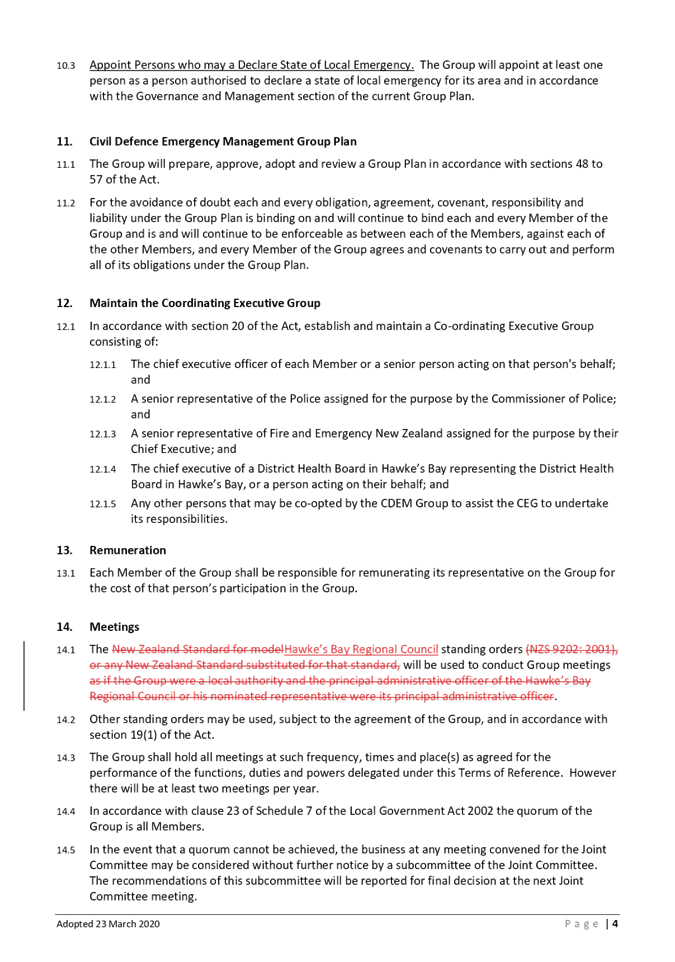
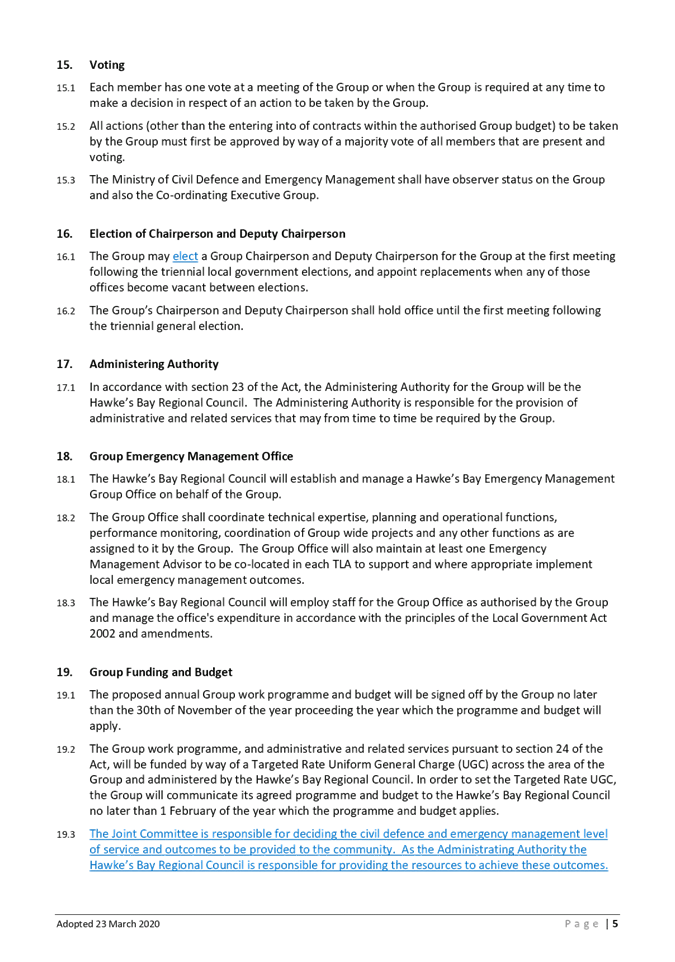
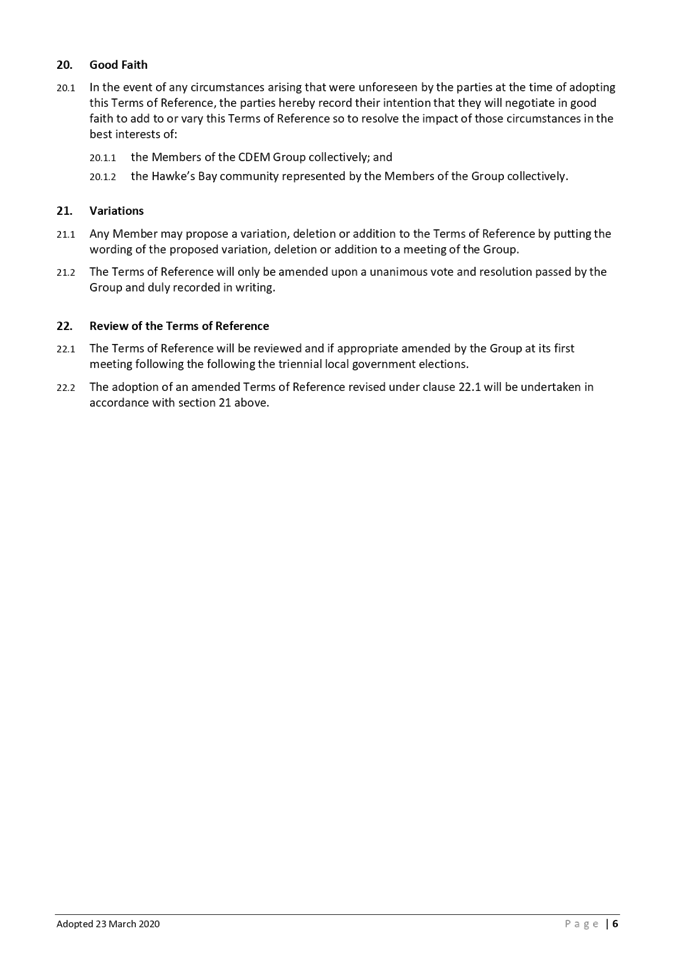
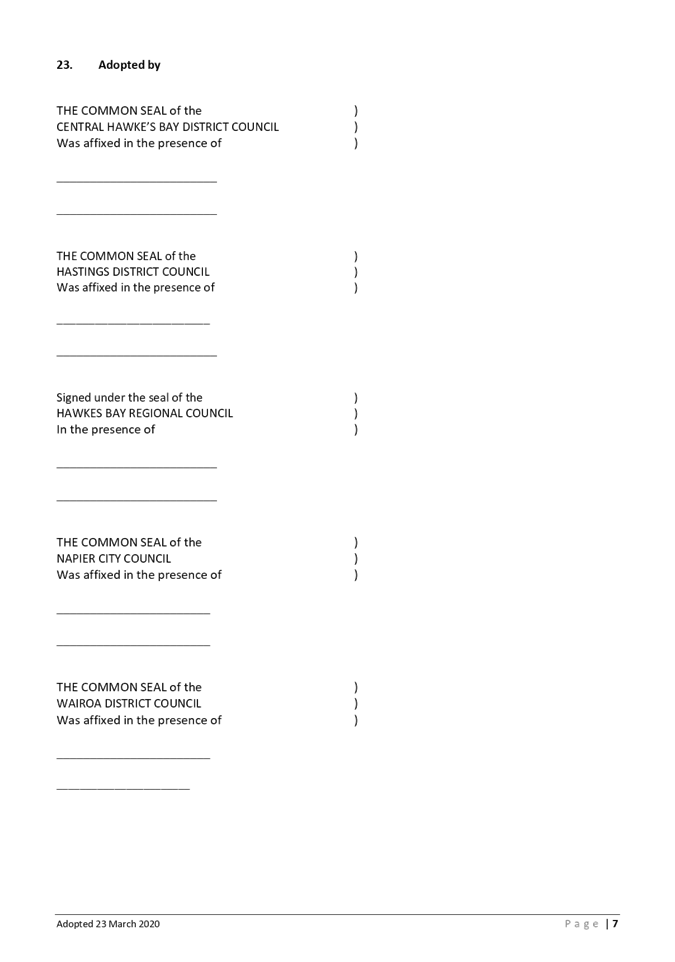
|
July 2022 adopted Ahuriri Regional Park Joint Committee Terms
of Reference
|
Attachment
11
|
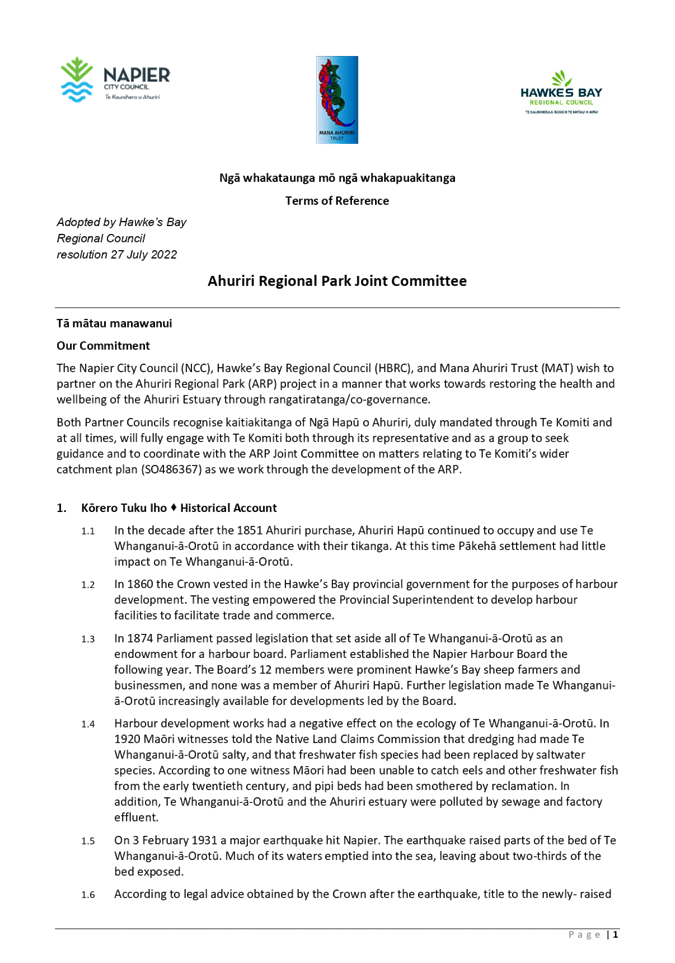
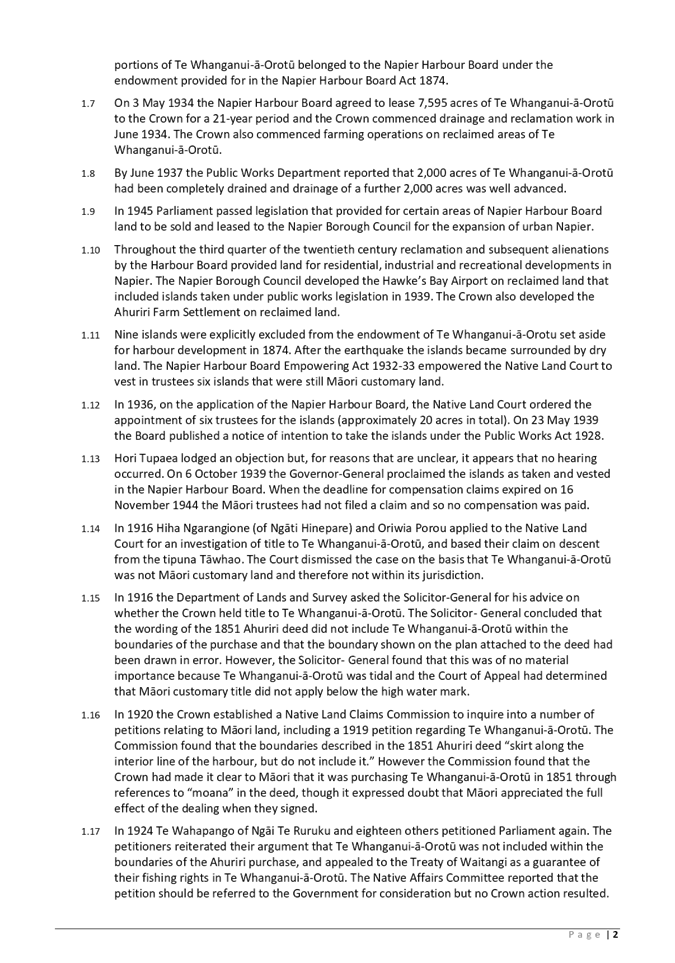
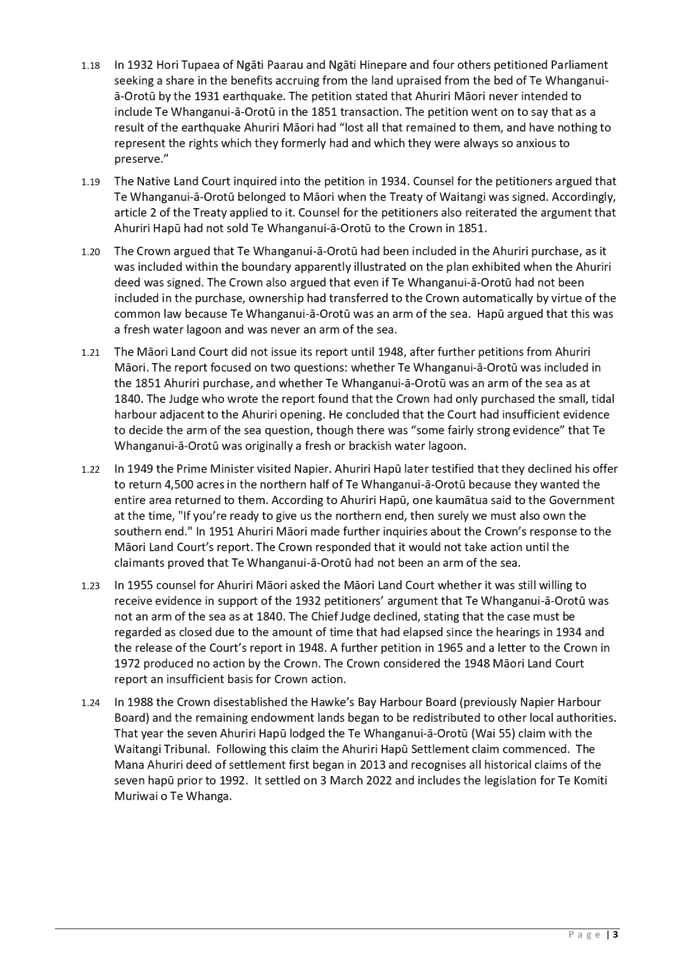
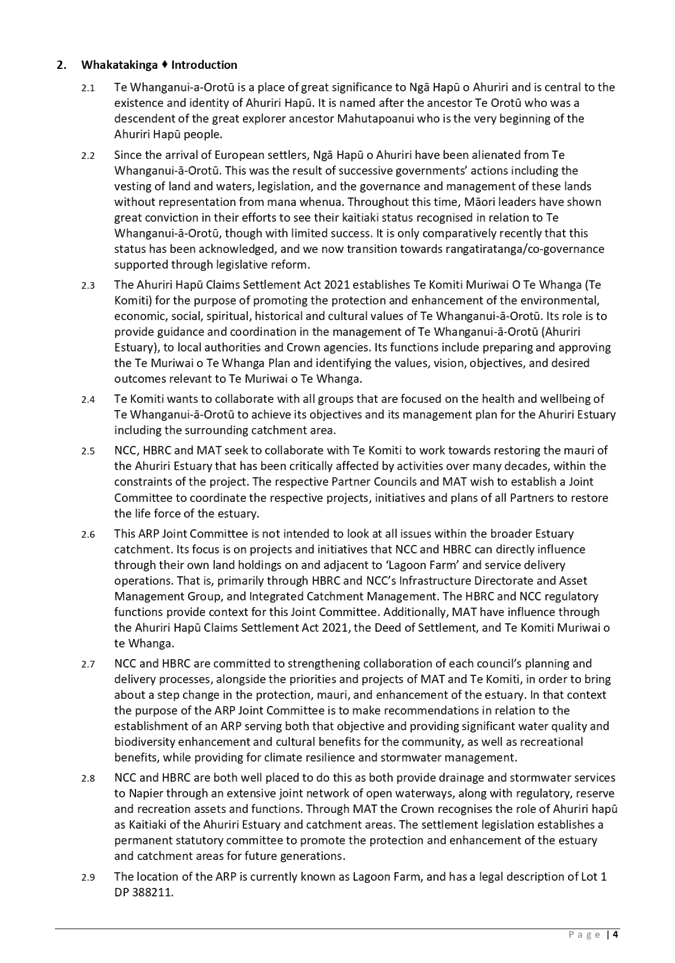
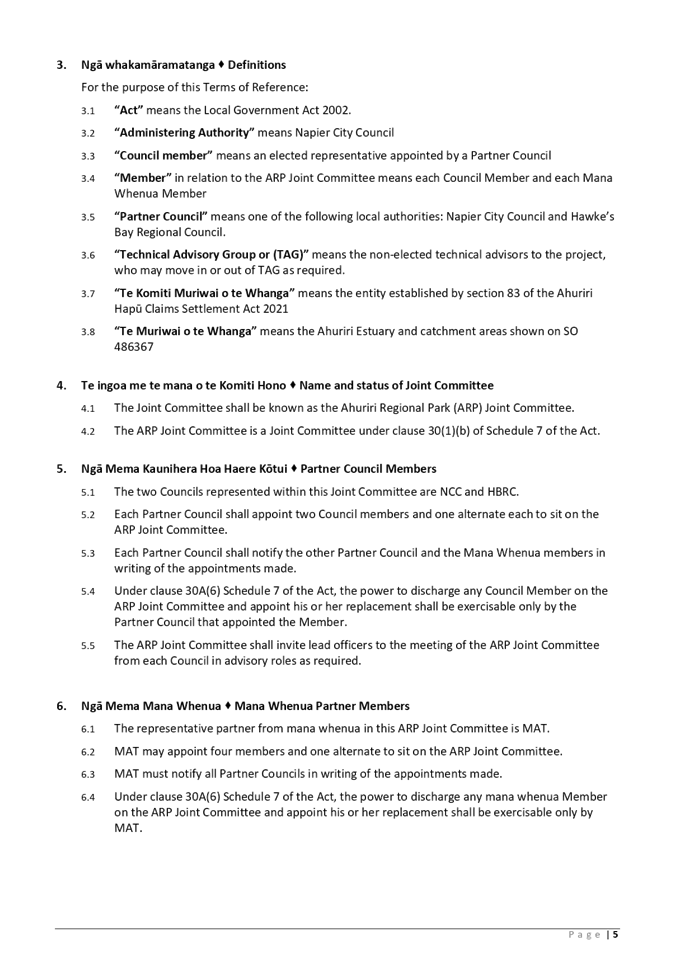
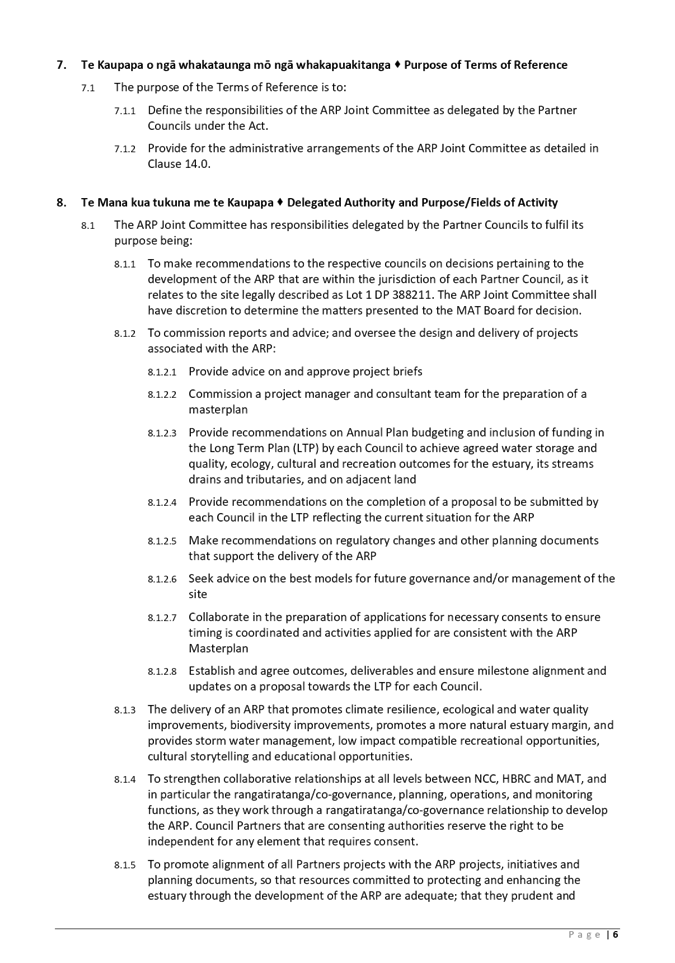
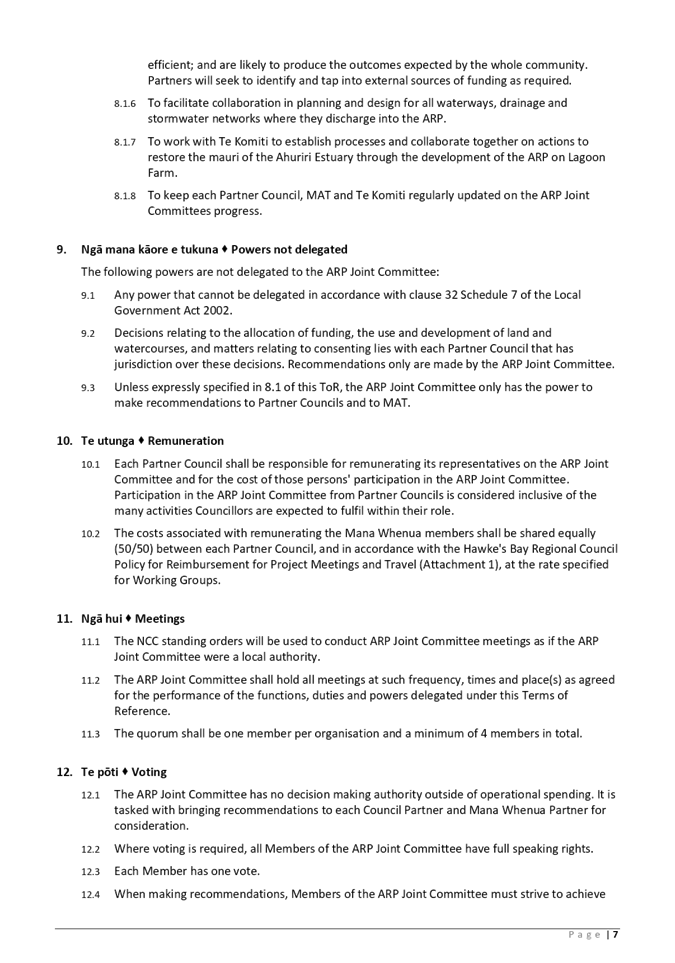
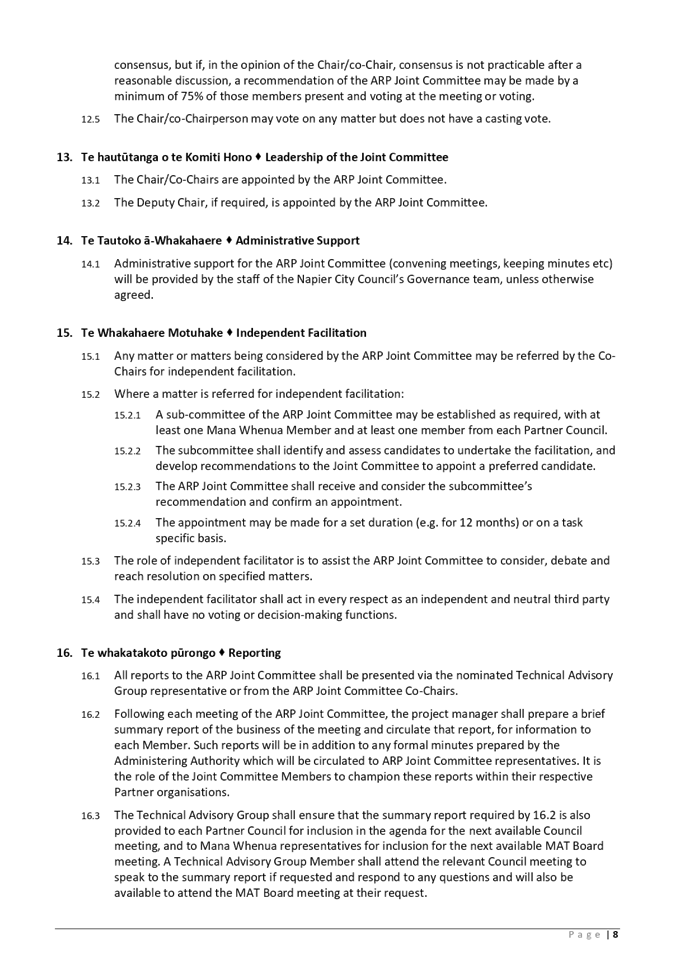
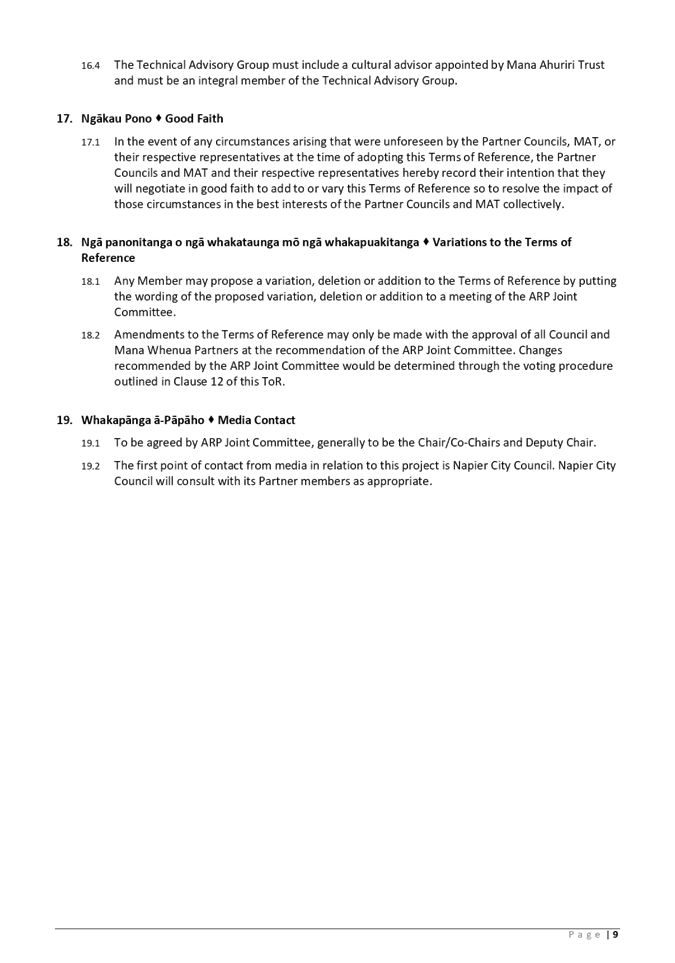
|
proposed 2022-25 Clifton to Tangoio Coastal Hazards Strategy
Joint Committee Terms of Reference
|
Attachment
12
|
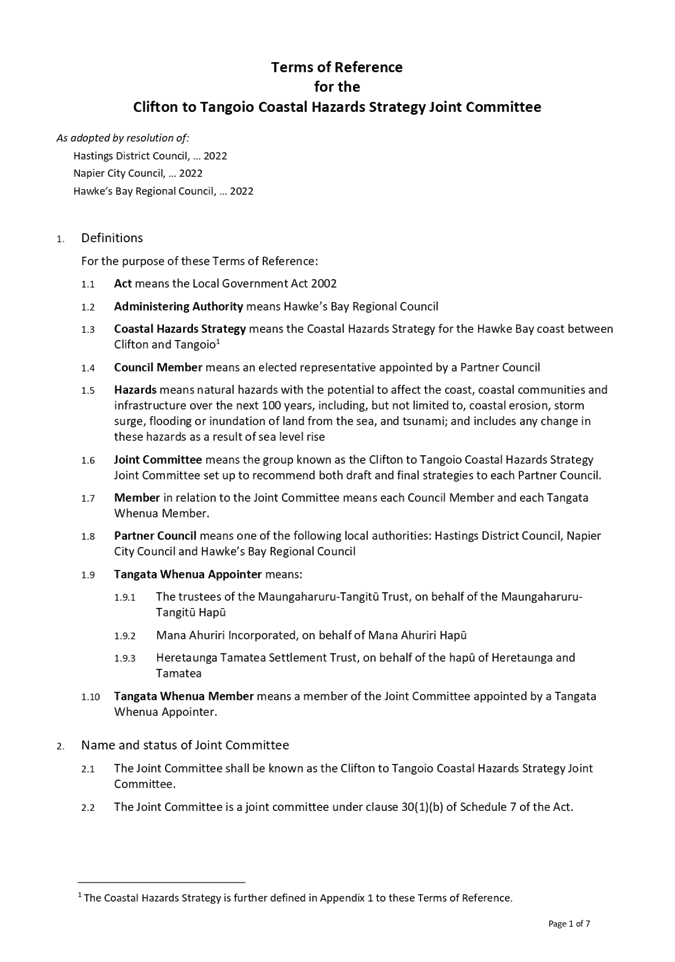
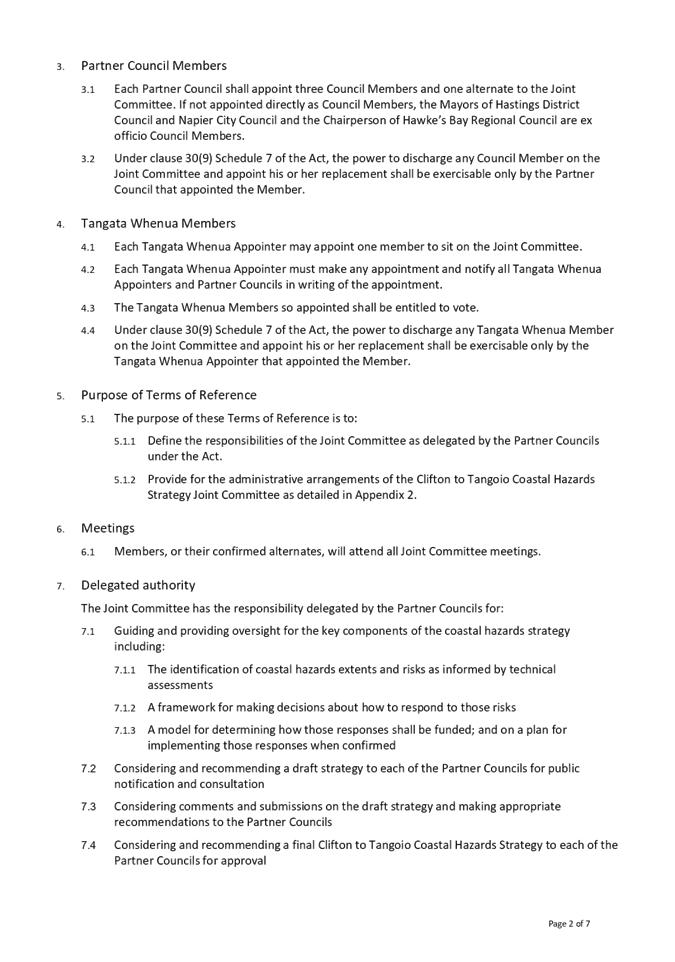
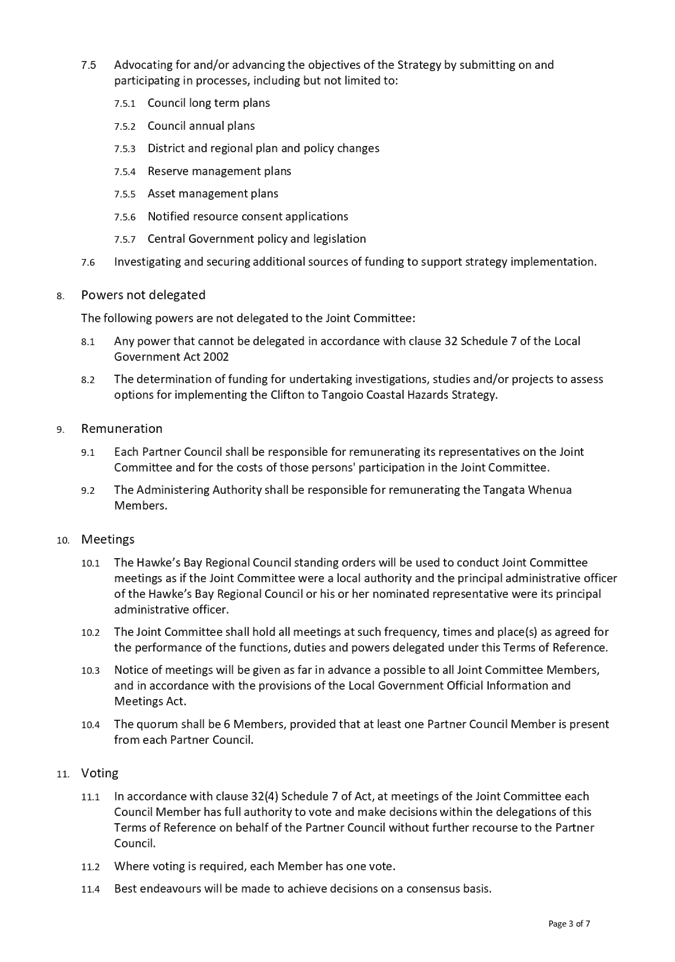
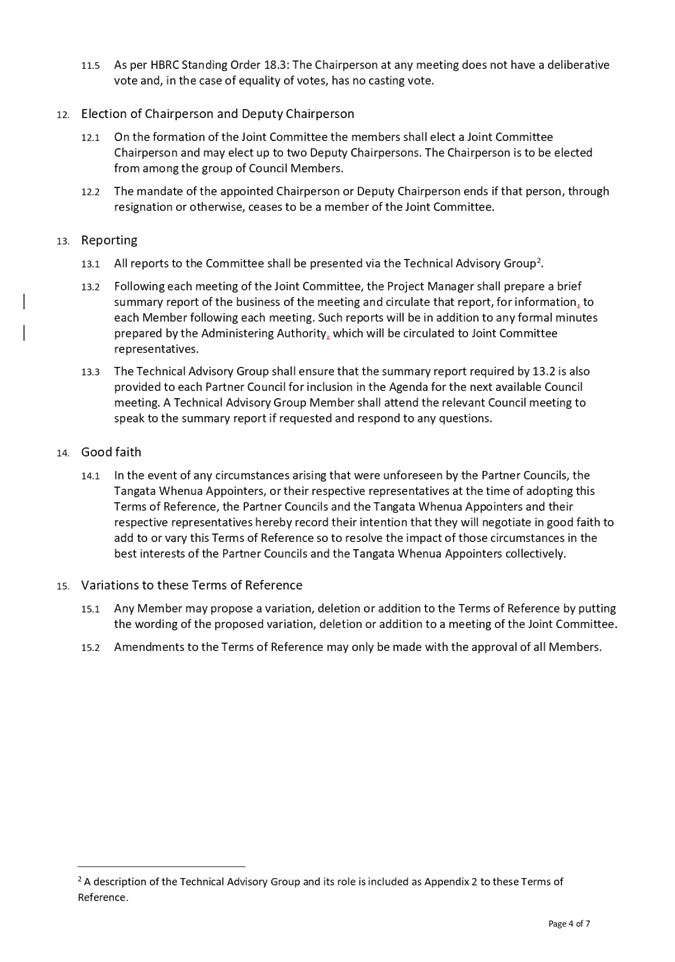

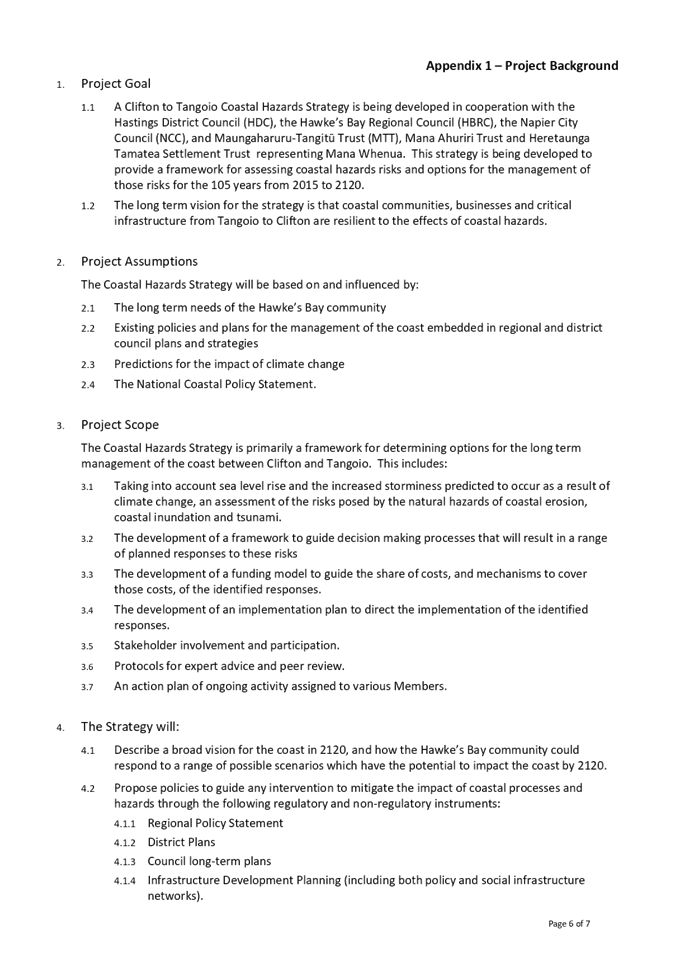
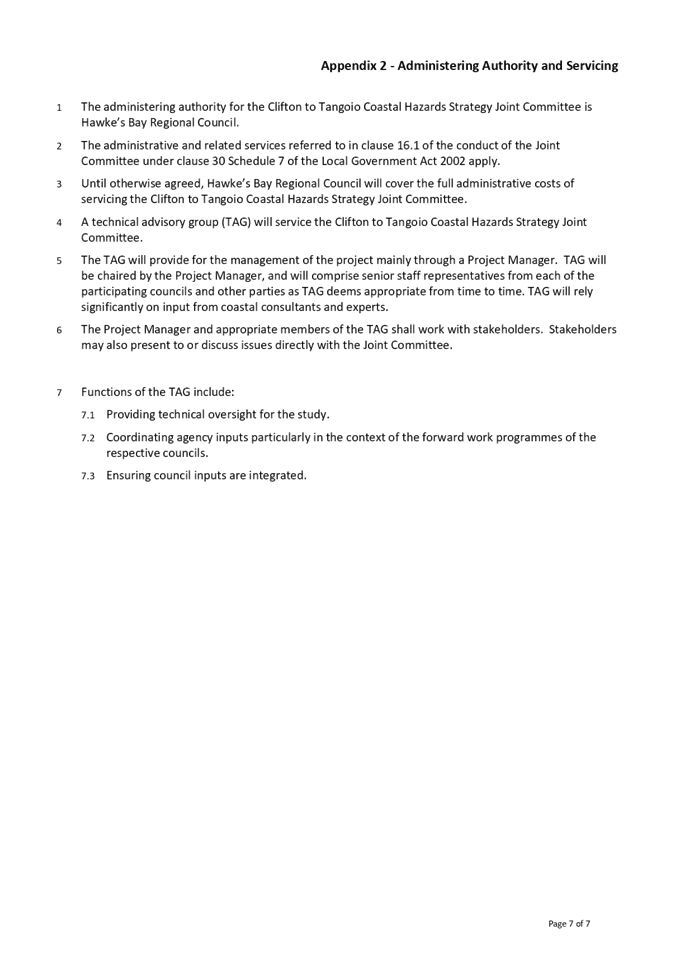
Hawke’s Bay Regional
Council
16
November 2022
Subject: Re-establishment of the
Biosecurity Working Party
Reason for Report
1. This item seeks the re-establishment
of the Biosecurity Working Party (BWP) to enable it to complete the Possum
Control Area partial plan review process and make its recommendations to
Council for decision.
Officers’
Recommendations
2. Council officers recommend
that the Biosecurity Working Party is re-established for one further meeting
with the membership and Terms of Reference as described in this item.
Executive
Summary
3. The Biosecurity Working
Party was established to hear submissions and make recommendations to Council
on proposed changes to Possum control delivery, and is a requirement of the
partial plan pest review process under the Biosecurity Act 1993.
4. Following Local Government
elections, the BWP was disestablished before making final recommendations after
the hearing process. This paper seeks to reinstate the BWP to make final
recommendations to council, including sections 71 to 74 (excluding sections
72(5)) and 100D(6)(b) of the Biosecurity Act 1991.
5. Further to the above,
sections 75(1) and (2) of the Biosecurity Act 1991 require a report to be
prepared on the Proposal to
change Possum Control Area delivery following the hearing of submissions and make
recommendations to the Regional Council for its decisions on Regional Pest
Management Plan amendments.
Background
6. The Regional Council
established the Biosecurity Working Party (BWP) in November 2021, and
provided it with delegations to hear submissions and make recommendations to
the Council on proposed changes to Possum control delivery. It was initially comprised
of 5 elected Councillors, two representatives from the Māori committee and
one independent advisor.
7. Since then, the BWP has
completed a number of interim steps under the BSA process. The Proposal
for the change was notified and subject to public consultation, and a hearing
of the verbal submissions received was held in August 2022. A total of 155
submissions were received and 9 submitters heard with 4 submitter statements
read out to the Hearing.
8. The BWP was discharged
following the 2022 local government elections, after the hearings were held but
prior to completing its delegated responsibilities (including the preparation
of a recommendation report on submissions).
9. The Council is now asked to
re-establish the BWP for one further meeting so that the required remaining
steps under the BSA can be completed and recommendations made to Council for
its final decisions.
10. Once the BWP is
re-established the remaining steps of the Possum Control Area partial plan
review process required by the Biosecurity Act will be able to be carried out.
Discussion
11. To maintain continuity
staff consider it prudent that the BWP is re-established with the same members
appointed as previously, and provided with the same delegations in order to
complete the Possum Control Area partial plan review process.
12. Given the BWP have
considered written submissions and heard verbal submissions, if the Regional
Council now makes the decisions on those submissions it may give rise to
natural justice issues as the new decision-makers were not part of the hearing
process.
13. To reinstate
the BWP, the Terms of Reference (ToR) will need to be amended as per the
proposed 2022 version (attached).
13.1. The 2021 ToR
required that 5 elected members be appointed. Due to Councillors Taylor and
Foss not being re-elected, staff propose that it is amended to 3 elected
members and they be those who have previously been on the BWP, being Cr Foley,
Cr van Beek and Cr Lambert.
13.2. Membership of
the BWP also included Mr John Simmons, an external consultant, and 2 HBRC
Māori Committee representatives. It is proposed that Mr Simmons is
re-appointed. Due to neither of the Māori Committee representatives being
in attendance for the Submissions and Hearing neither are proposed for
re-appointment.
13.3. The quorum is
amended to ‘majority of members’.
Significance
and Engagement Policy Assessment
14. The decision sought in this
item is low under the criteria contained in council’s adopted
Significance and Engagement Policy as it is only seeking to re-instate an
already previously established working party to make final recommendations to
Council.
Financial
and Resource Implications
15. When determining the
appropriate cost allocation for this programme, the Council must consider how
the costs will be shared amongst:
15.1. Those people who have an
interest in the plan
15.2. Those who benefit from the
plan (including collective benefits), and
15.3. Those who contribute to the
pest problem and who pose a risk of spreading a pest through their activities.
16. These factors have been
considered as part of the development of this Proposal and will continue to be
considered under section 100T of the Act when the funding split is confirmed as
part of the review of the Revenue and Finance Policy. No Council
decisions on new PCA budgets or any revised allocation of costs have been made.
These issues will be considered and discussed with the community as part of the
2024 Long-Term Plan (LTP). The changes envisioned in this proposal are
enabling, but would not be enacted until the LTP and the Revenue and Financing
Policy have been reviewed.
Decision Making Process
17. Council and its committees
are required to make every decision in accordance with the requirements of the
Local Government Act 2002 (the Act). Staff have assessed the requirements in
relation to this item and have concluded:
17.1. The decision does not
significantly alter the service provision or affect a strategic asset, nor is
it inconsistent with an existing policy or plan.
17.2. The use of the special
consultative procedure is not prescribed by legislation.
17.3. The decision is not
significant under the criteria contained in Council’s adopted
Significance and Engagement Policy.
17.4. The persons affected by
this decision are those who submitted to the Proposal to change PCA delivery.
17.5. Given the nature and
significance of the issue to be considered and decided, and also the persons
likely to be affected by the decisions made, Council can exercise its
discretion and make the decision without consulting directly with the community.
Recommendations
That Hawke’s Bay Regional Council:
1. Receives and considers the Re-establishment
of the Biosecurity Working Party staff report.
2. Agrees that the decisions
to be made are not significant under the criteria contained in Council’s
adopted Significance and Engagement Policy, and that Council can exercise its
discretion and make decisions on this issue without conferring directly with
the community or persons with an interest in the decision.
3. Re-establishes the
Biosecurity Working Party as a sub-committee of the Regional Council with its
membership comprising Councillors Will Foley, Jerf van Beek and Charles Lambert
and Mr John Simmons.
4. Delegates to the
Biosecurity Working Party the authority
to carry out activities within its Terms of Reference including the duties,
powers and functions of the Council:
4.1. Set out in sections 71 to
74 (excluding sections 72(5)) and 100D(6)(b) of the Biosecurity Act 1991
4.2. Set out in sections 75(1)
and (2) of the Biosecurity Act 1991 to prepare a written report on the Proposal
to change Possum
Control Area delivery
following the hearing of submissions and make recommendations to the Regional
Council for its decisions on Regional Pest Management Plan amendments.
Authored by:
|
Leeanne Hooper
Team Leader Governance
|
Lauren Simmonds
Project Manager - Biosecurity Review
|
Approved by:
|
Iain Maxwell
Group Manager Integrated Catchment
Management
|
|
Attachment/s
|
1⇩
|
Biosecurity Working Party Terms of
Reference 2022
|
|
|
|
Biosecurity Working Party Terms of
Reference 2022
|
Attachment
1
|
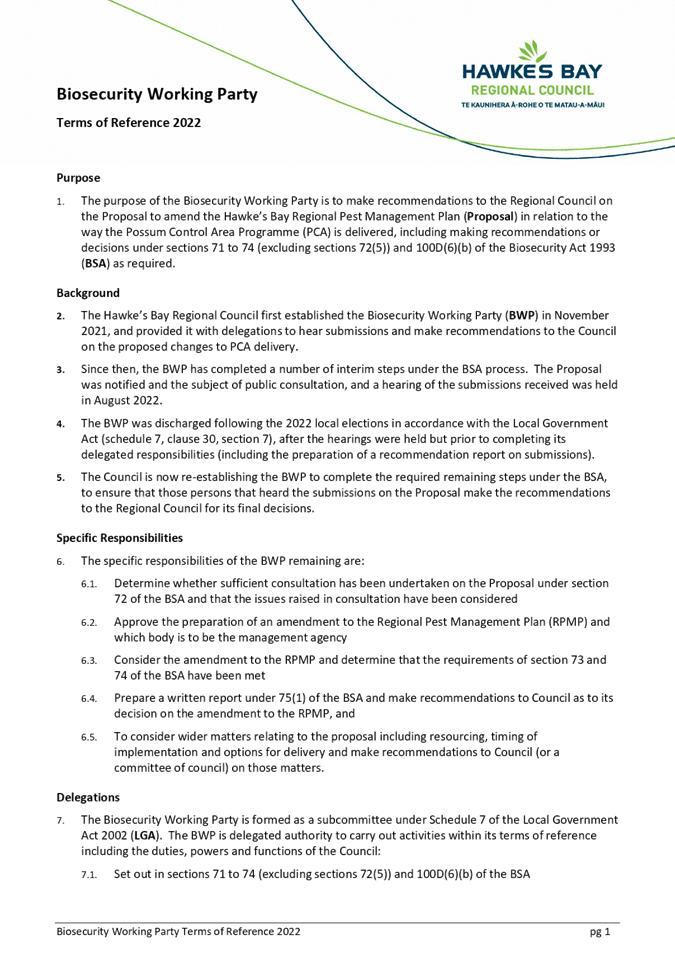
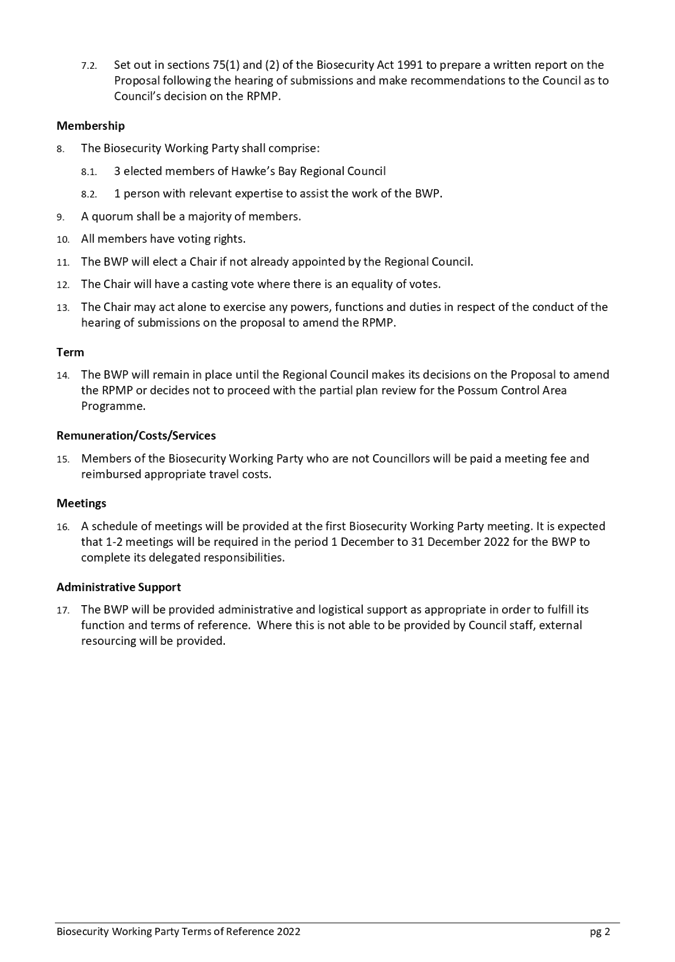
Hawke’s Bay Regional
Council
16
November 2022
Subject: Director appointments to
Hawke’s Bay Regional Investment Company and Napier Port Holdings Limited
Reason for report
1. This item outlines the
means for Council to
make director appointments to the Council Controlled Trading Organisations of
Hawke’s Bay Regional Investment Company and Napier Port Holdings Limited
in accordance with Council’s Policy on Appointment and Remuneration of Directors, as revised and adopted in
April 2022.
Officers’
recommendations
2. Council officers request
that Councillors wishing to be considered as Councillor Directors of HBRIC
indicate such to inform the Chairperson.
3. Council officers recommend
that the Council establishes the Council Appointments Committee (CAC) in accordance with
the Policy
on Appointment and Remuneration of Directors (the Policy) (attached) in order to
initiate the process of interviewing, selecting and recommending to Council
directors for the HBRIC board.
4. Councillors are asked to
note the willingness of HBRIC’s current independent Chair to serve a
third and final term in that role, and to consider that reappointment as a part
of this appointment process.
Background
5. The Hawke’s Bay Regional
Investment Company Ltd (HBRIC) is a council-controlled organisation set up to
manage some of the Regional Council’s larger infrastructure investments.
6. In the last triennium HBRIC
had three councillor directors and one independent director acting as Chairman
and non-independent director of Napier Port Holdings Limited. HBRIC can have a
maximum of eight directors.
7. During the last triennium
Council expressed a preference to appoint an additional independent director
following the 2022 Local Government elections.
Council
Appointments Committee
8. In accordance with the Policy
on Appointment and Remuneration of Directors, the Council shall establish a CAC after each
triennial local body election to recommend to Council the appointment of HBRC
councillor, HBRC executive (if nominated) and independent Directors to HBRIC
Ltd.
9. The CAC will be comprised
of four members who are not seeking appointment to the HBRIC Ltd
Board. Where possible the CAC members will include the current
Chair of HBRIC Ltd, two current councillors, and an external
experienced director.
10. The CAC will remain
appointed for the duration of the electoral term and preside over appointment
decisions during that term as required.
11. The CAC
will interview all Councillors expressing an interest in appointment to the
HBRIC Ltd Board, including existing HBRIC Ltd Council directors retiring and offering
themselves for re-appointment, and any HBRC executives duly nominated by the
HBRC Chief Executive.
12. In the process of selecting
directors the CAC, having consulted the HBRIC Ltd Board for its advice, will
first determine the required skills, knowledge and experience which is
necessary for an effective Board. In general terms, the CAC will apply similar
criteria to potential candidates to those used by HBRIC Ltd in its assessment
of candidates for CCTOs, namely:
12.1. Intellectual ability
12.2. Commercial experience
12.3. Understanding of governance
issues
12.4. Sound judgement
12.5. High standard of personal
integrity
12.6. Commitment to the
principles of good corporate citizenship
12.7. Understanding of the wider
interests of the publicly-accountable shareholder
12.8. Governance experience.
13. As a general principle,
HBRIC Ltd will seek to appoint a person who, while meeting all of the above
criteria, has particular strengths in terms of the attribute
“Understanding of the wider interests of the publicly-accountable
shareholder”. However, where necessary the CAC will also take into
account a candidate’s potential to quickly acquire the business and
financial skills, as well as his or her existing skills and experience.
14. The candidate’s
skills must be relevant to the requirements of HBRIC Ltd in terms of its
governance and provide, as far as possible, that there is a suitable
cross-section of skills available at the board table capable of meeting the
normal criteria of good governance.
15. The CAC must consider how
any appointments promote diversity and inclusion, with open and transparent
appointment processes.
16. The CAC may use the
services of a specialist consultant in making an assessment of the suitability
of candidates.
HBRIC Chairperson
17. Historically,
Council’s stated preference is for the Chair to be an independent
director.
18. The policy points to
continuity as being valuable, and for there to be a lead-in succession process
of at least one year before the retirement of the incumbent (refer to Appendix
1 of the Policy).
19. The CAC is responsible for
making a recommendation to the Regional Council on the nomination of the HBRIC
Ltd chairperson.
20. As per the Policy on Appointment
and Remuneration of Directors, following interviews the
CAC will make its final recommendations in a report to the Regional Council.
20.1. The recommendations report
will be considered in the public-excluded part of the Agenda
20.2. The Council will consider
the recommendations and make its decision
20.3. Public announcement of the
appointments will be made as soon as practicable after the Council has made its
decision.
21. Current councillor
directors must resign on a date specified by the Council, no later than three
months after the triennial local body elections, although they may offer
themselves for re-appointment.
Strategic Fit
22. HBRIC plays an important
role in the oversight of its investment portfolio, particularly Napier Port
Holdings Limited.
23. Through its Statement of
Intent, HBRC endorses HBRIC’s mission to optimise the financial and
strategic returns to Council from its allocated investment portfolio to assist
Council achieve its vision of “a healthy environment, and a resilient and
prosperous community”.
Financial
and Resource Implications
24. HBRIC Councillor directors
are to be paid for their director duties only if they are not already
remunerated for higher duties as Council committee chairs or Council
Chairperson or Deputy, and in such event are to be paid for the difference
between a base councillor salary and that of a Council committee Chair.
Decision Making Process
25. Council and its committees
are required to make every decision in accordance with the requirements of the
Local Government Act 2002 (the Act). Staff have assessed the requirements in
relation to this item and have concluded:
25.1. The decision does not
significantly alter the service provision or affect a strategic asset.
25.2. The use of the special
consultative procedure is not prescribed by legislation.
25.3. The decision does not fall
within the definition of Council’s policy on significance.
25.4. The persons affected by
this decision are councillors themselves.
25.5. Given the nature of the
decisions to be made, Council can exercise its discretion and make them without
consulting directly with the community or others with an interest in the
decisions.
Recommendations
That Hawke’s Bay Regional
Council:
1. Receives and considers the Director
appointments to Hawke’s Bay Regional Investment Company and Napier Port
Holdings Limited staff report.
2. Agrees that the Council can
exercise its discretion and make decisions on this issue without conferring
directly with the community or persons likely to have an interest in the
decision.
3. Establishes the Council
Appointments Committee comprised of [confirm appropriate names during meeting]
4. Instructs the Council
Appointments Committee to initiate the process to shortlist, interview and
select preferred candidates for recommendation to Council for appointment as
directors of the Hawke’s Bay Regional Investment Company Limited.
Authored by:
|
Tom Skerman
HBRIC Commercial Manager
|
|
Approved by:
|
Susie Young
Group Manager Corporate Services
|
|
Attachment/s
|
1⇩
|
Policy on Appointment and
Remuneration of Directors
|
|
|
|
Policy on Appointment and Remuneration of
Directors
|
Attachment
1
|
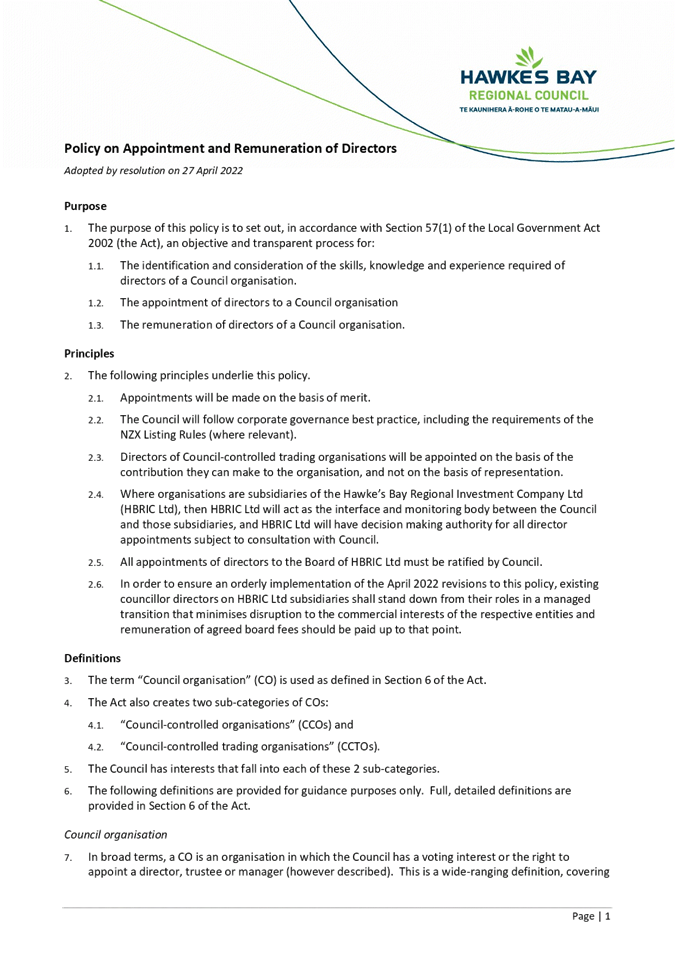

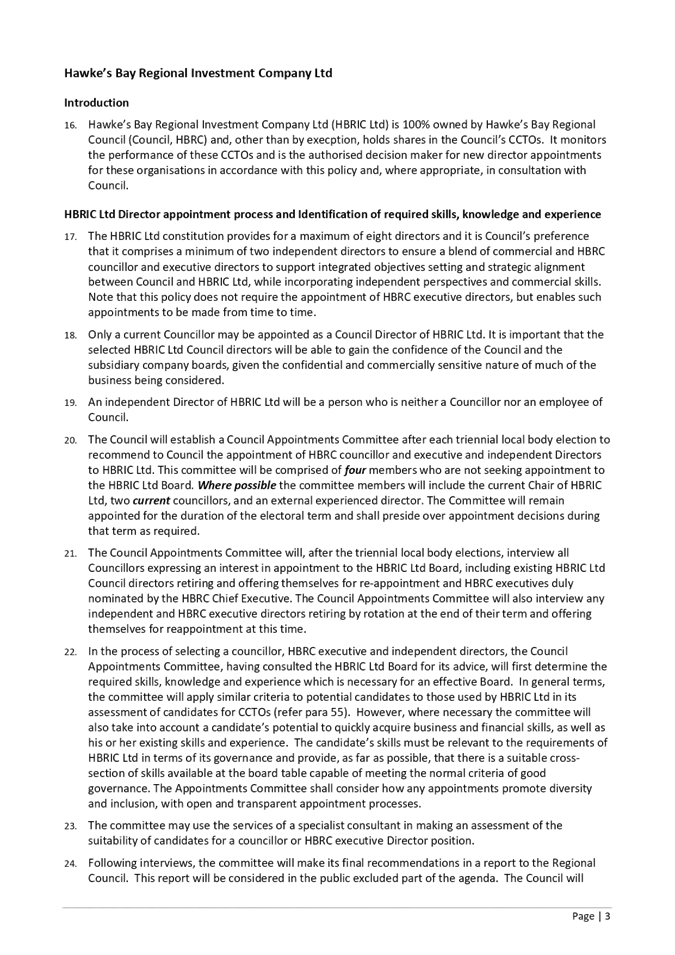
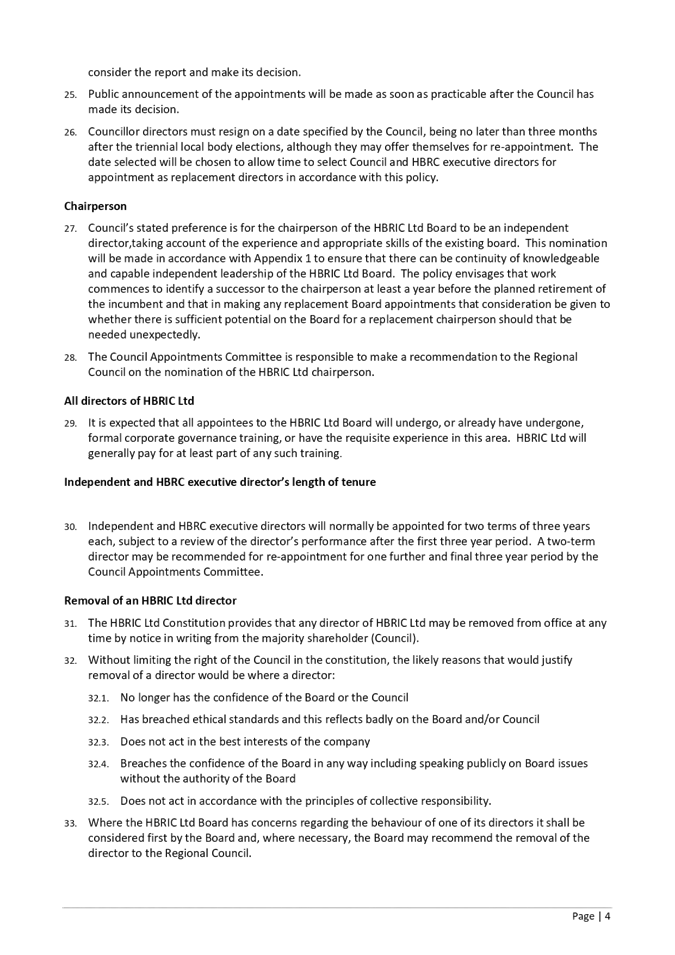

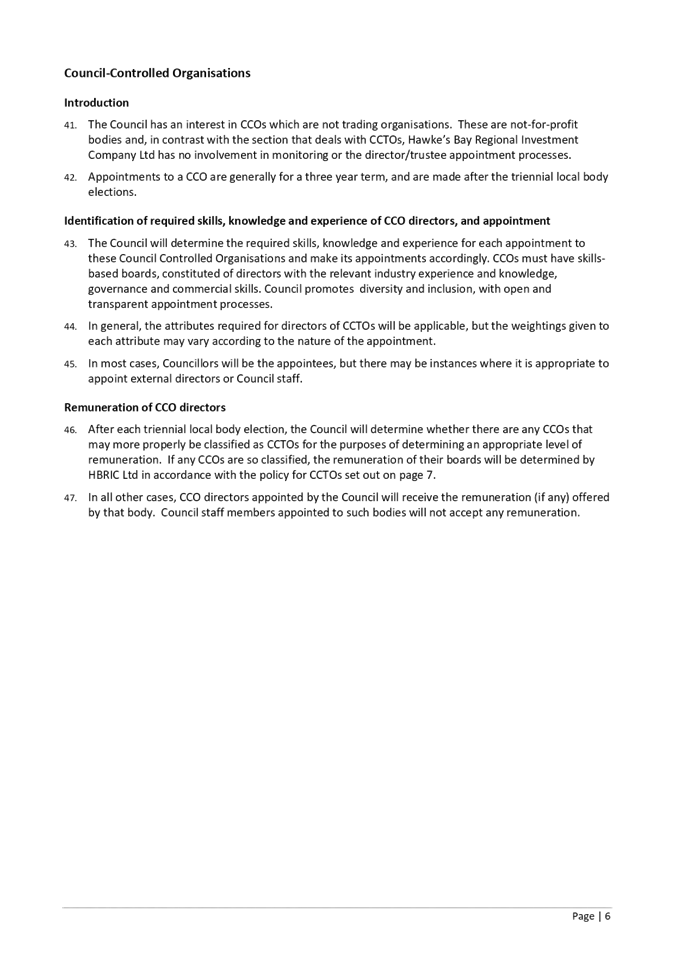
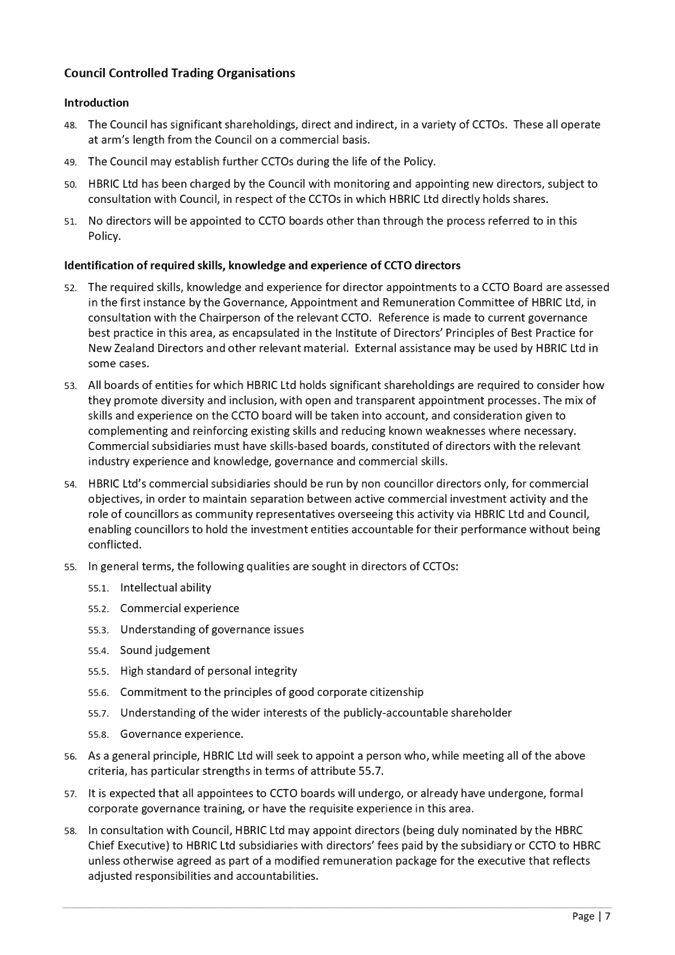
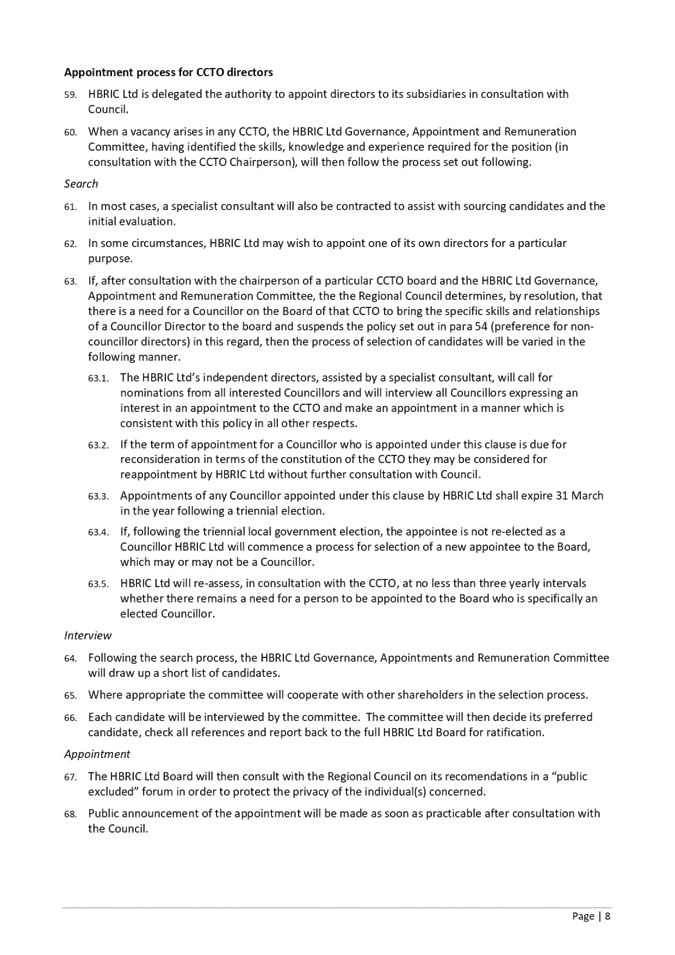
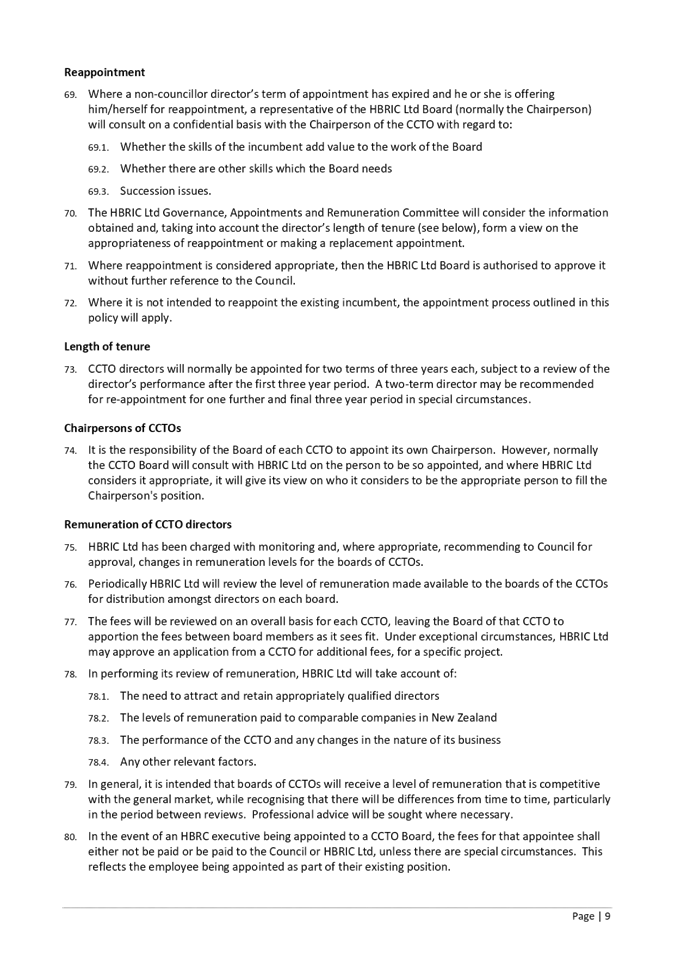

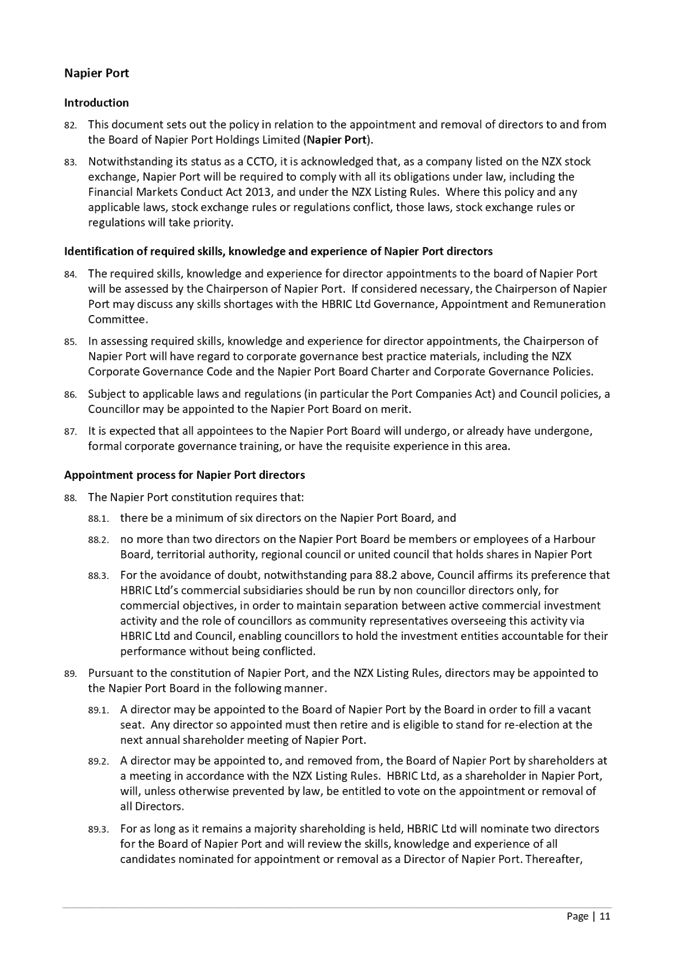
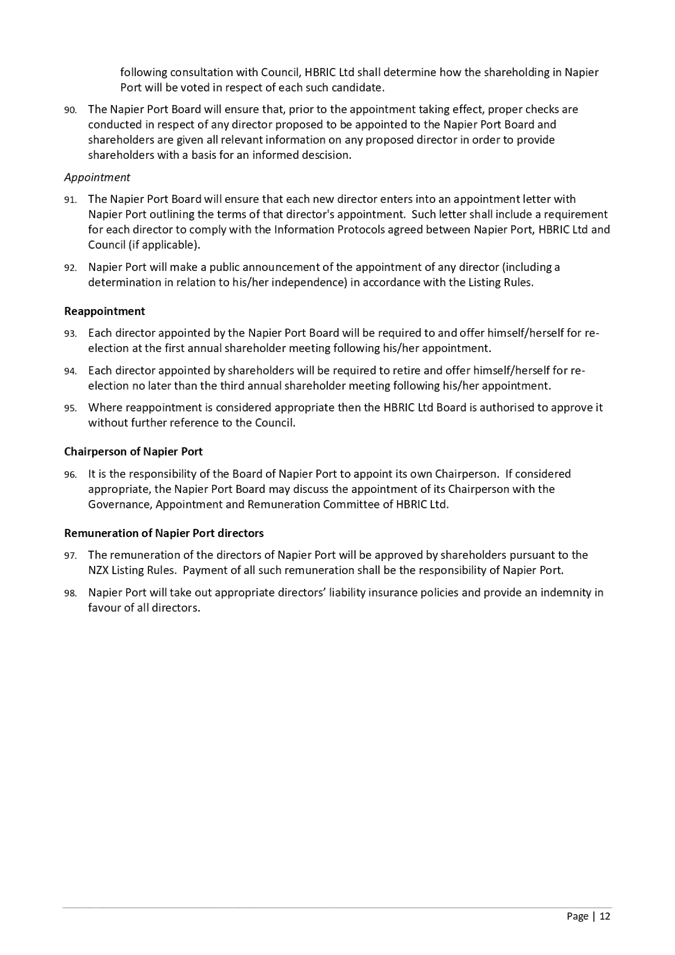
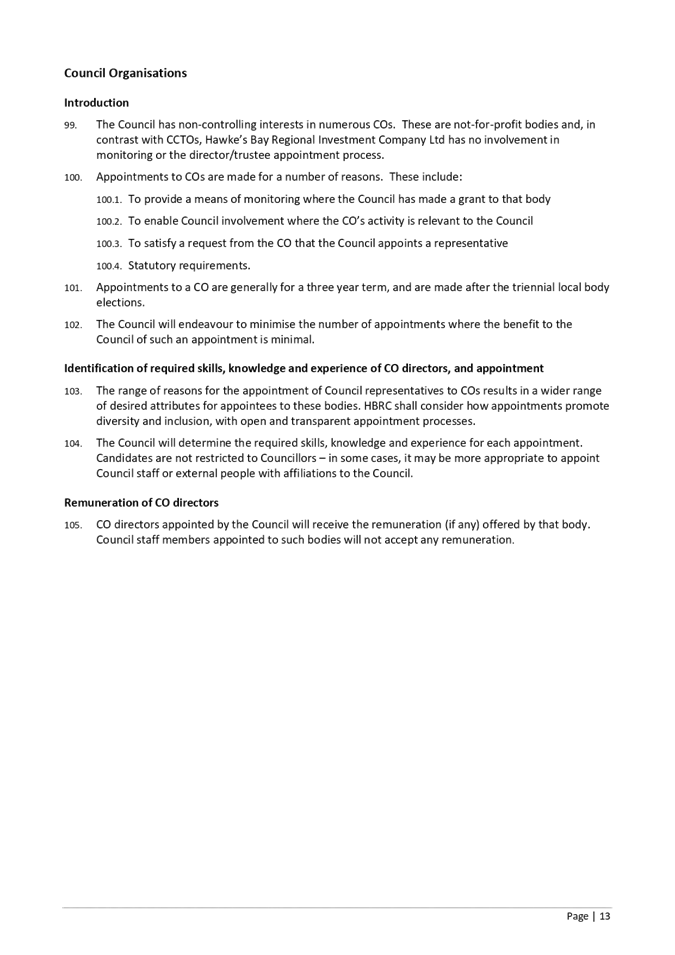
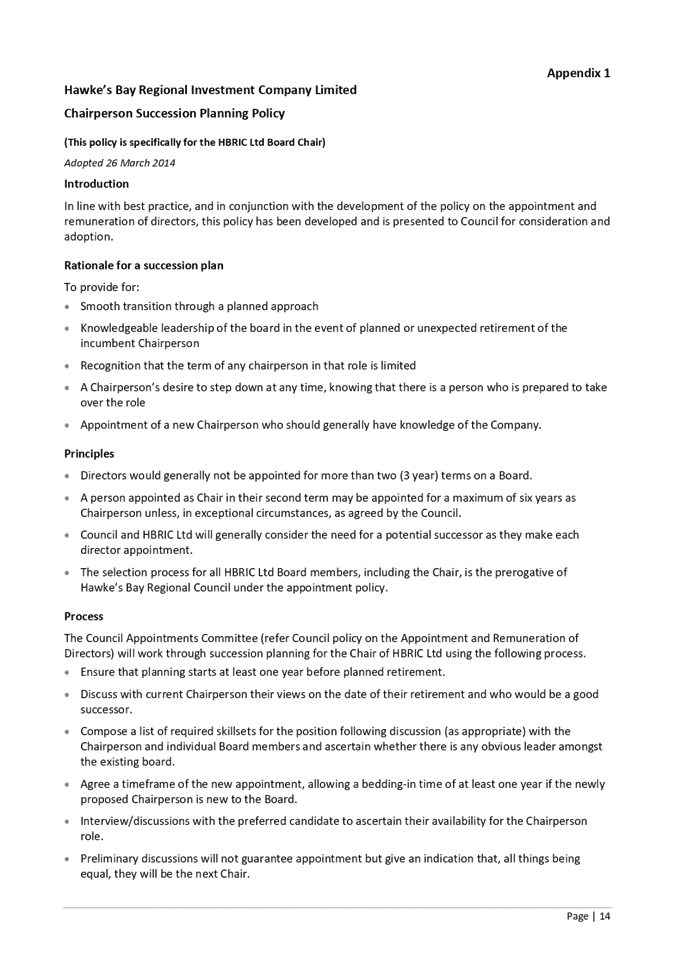

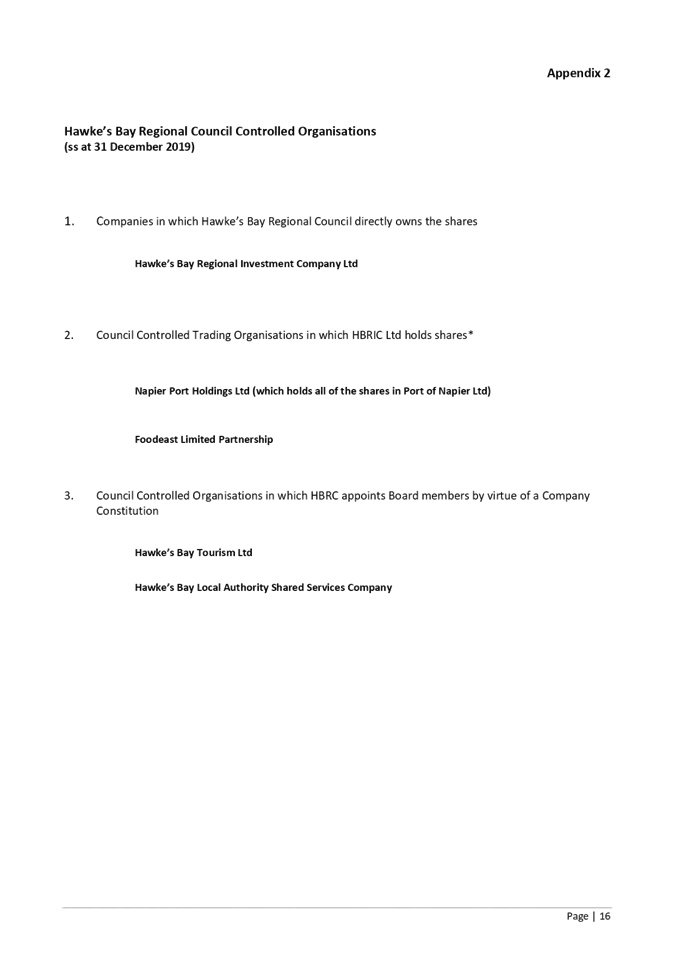

Hawke’s Bay Regional
Council
16
November 2022
Subject: Councillor appointments to
outside bodies
Reason for Report
1. This item provides the
means for Council to make appointments to external bodies, groups and
organisations that provide Council with valuable input into policy, plan and
strategy development processes. Representation on external bodies may
have been requested, and/or may be where Council has a financial or other
interest.
2. The role of councillors on
these various organisations is not to direct or lead the group (except where
appointed or elected by the group to do so) but instead it is to inform the
group of Council’s view and to act as a conduit for the group back to
Council.
Entity
Representation
Te
Komiti Muriwai o Te Whanga
3. The Ahuriri Hapū
Claims Settlement Act 2021 established Te Komiti Muriwai o Te Whanga (Te
Komiti). Te Komiti’s purpose and functions include preparation and
approval of the Te Muriwai o Te Whanga Plan as detailed in Attachment 3.
4. Te Komiti wants to
collaborate with all groups that are focused on the health and wellbeing of Te
Whanganui-ā-Orotū to achieve its objectives and its management plan
for the Ahuriri Estuary including the surrounding catchment area.
5. Te Komiti membership, in accordance with the
Ahuriri Hapū Claims Settlement Act 2021 includes 1 member appointed by
Hawke’s Bay Regional Council.
6. It is recommended that Councillor
Neil Kirton is re-appointed to Te Komiti Muriwai o Te Whanga in order to
provide continuity for both te Komiti and the Council.
TBfree
Hawke’s Bay Committee
7. This Committee is TBfree New Zealand’s
(previously
known as the Animal Health Board) link to the local community. OSPRI is the parent company
of TBfree, with responsibilities to eradicate Bovine TB from domestic herds in
New Zealand. Their funding is sourced from Government and the dairy, beef and
deer sectors.
8. This Committee provides
advice on the programme for the eradication of Bovine Tuberculosis from
domestic herds in Hawke’s Bay. HBRC has, in the past, worked closely with
the TBfree Committee when providing vctor management services under contract to
OSPRI. This is no longer the case, and for the past several years coordination
with OSPRI has been largely handled at a staff level.
9. Council is, however able to
appoint a political representative to the Committee if they choose to do so. It
is recommended that Council considers whether or not they wish to have
political representation on the TBfree HB Committee, and if so appoint one
councillor representative.
Hawke’s
Bay Future Farming Charitable Trust
10. The Future
Farming Trust was established and funded in the
Hawke’s Bay Regional Council’s 2018 Long Term Plan. HBRC's intent
was to establish an independent voice to champion sustainable agriculture in
Hawke's Bay.
The Trust’s vision is to make Hawke’s Bay farming the pride of
our entire community, and its mission to promote,
inspire and celebrate profitable farming systems that enrich the environment
and the community.
11. The composition of the
Trust Board, as per the HB FFT Trust Deed, is a minimum of three and a maximum
of nine individuals including one Council-appointed trustee. It is recommended
that Councillor Will Foley is re-appointed to the HB Future Farming Charitable
Trust in order to provide continuity for both the Trust and the Council.
Hawke’s
Bay Tourism
12. Hawke’s Bay Tourism
is the official Regional Tourism organisation (RTO) for Hawke’s Bay. It is governed by a Board, which
includes a representative from the Hawke’s Bay Regional Council.
13. HB Tourism is a membership-based
organisation and offers two partnership programme models.
13.1. Industry Partner –
for businesses with a direct relationship to the visitor industry e.g.
accommodation, transport operators, attractions, retailers, hospitality
industry and wineries.
13.2. Support Partner – for
support service businesses, industry and sector associations and those with a
genuine desire to support economic development in Hawke’s Bay through
tourism initiatives.
14. The Board of HB Tourism
meets approximately every six weeks and undertakes:
14.1. Governance of HB Tourism,
including progress towards achieving key performance indicators
14.2. Extensive stakeholder
engagement with tourism operators, central and local government and other
agencies
14.3. Consideration of new
initiatives for tourism in Hawke’s Bay (for example, F.A.W.C! Food and
Wine Classic)
15. Hawke’s Bay Tourism
is jointly funded by the Hawke’s Bay Regional Council and the local
tourism industry through the Hawke’s Bay Tourism Industry Association.
16. Council is asked to appoint
one councillor to the Board of Hawke’s Bay Tourism.
Hawke’s
Bay Sports Council
17. The Hawke’s Bay
Sports Council is a forum of members directly involved in the provision of
sport and active recreation opportunities for the people of Hawke’s
Bay. It exists to ensure that those organisations with fundamental roles
in the provision of sport and active recreation opportunities, engage in a
collaborative, structured, transparent and strategic manner to ensure a
successful regional model for sport and active recreation provision.
18. The Council meets on a
quarterly basis at Sport Hawke’s Bay’s offices, and Council is
asked that one councillor be appointed to the Hawke’s
Bay Sports Council.
Local
Government New Zealand
19. Council is a member of
Local Government New Zealand (LGNZ) which is the national body representing the
interests of all Local Authorities in New Zealand.
20. The Country is divided into
six ‘Zones’ which meet periodically, of which HBRC belongs to Zone
3. Council’s Chairperson has traditionally represented the Council at
these meetings and other Councillors may attend when relevant items of interest
appear on the agenda.
21. The Chairperson also
attends, as the Council’s representative, the Regional Sector Group which
is a Committee of LGNZ representing all regional and unitary authorities.
22. It is necessary to
formalise Council’s representation on the various bodies of Local
Government New Zealand. It is recommended that the Council Chair represents the
Council on the Regional Sector Group. Council may wish to nominate one or more
Councillors to be a standing representative(s) at LGNZ Zone 3 meetings or seek
attendees on a meeting per meeting basis.
23. There are usually four
Regional Sector Group and Zone 3 meetings held each year, and one 3-4 day LGNZ
conference. It has been past practise for any Councillor who wishes to attend
the annual LGNZ conference to be funded to do so and it is recommended that
this practice continue.
24. The Council pays $40,280
per year to LGNZ for membership fees, and travel and accommodation costs
associated with elected representative meeting attendance are covered by
Council as well.
25. The Council is asked to
appoint one or more councillors as the Council’s representative(s) at
LGNZ Zone 3 meetings.
Matariki
Governance Group
26. Matariki is the
over-arching governance structure for Hawke’s Bay, providing for
co-governance through the Matariki Governance Group (MGG).
27. MGG provides oversight for
the delivery of the Matariki Hawke’s Bay Regional Development Strategy
for economic, inclusive and sustainable growth. The vision for the Strategy is
“Every whānau and every household is actively engaged in and
benefiting from growing a thriving Hawke’s Bay economy”.
28. Membership of MGG comprises
the Mayors/Chair of councils and Chairs/Chief Executives of the region’s
post settlement iwi organisations, and previously the Chair of the District
Health Board. Representation from business is also being planned.
Decision Making Process
29. Council and its committees
are required to make every decision in accordance with the requirements of the
Local Government Act 2002 (the Act). Staff have assessed the requirements in
relation to this item and have concluded:
29.1. The decision does not
significantly alter the service provision or affect a strategic asset, nor is
it inconsistent with an existing policy or plan.
29.2. The use of the special
consultative procedure is not prescribed by legislation.
29.3. The decisions are not
significant under the criteria contained in Council’s adopted
Significance and Engagement Policy.
29.4. The persons affected by
this decision are those bodies seeking Council representation.
29.5. Given the nature and
significance of the issues to be considered and decided, and also the persons
likely to have an interest in the decisions made, Council can exercise its
discretion and make these decisions without consulting directly with the
community.
Recommendations
That Hawke’s Bay Regional
Council:
1. Receives and considers the Councillor
appointments to outside bodies staff report.
2. Agrees that the decisions
to be made are not significant under the criteria contained in Council’s
adopted Significance and Engagement Policy, and that Council can exercise its
discretion and make decisions on this issue without conferring directly with
the community or persons likely to have an interest in the decision.
3. Reappoints Councillor Neil
Kirton as Council’s representative on Te Komiti Muriwai o Te Whanga.
4. Appoints Councillor
___________ as Council’s representative on the TBfree Hawke’s Bay Committee.
5. Reappoints Councillor Will
Foley as Council’s representative on the Hawke’s Bay Future Farming
Charitable Trust board.
6. Appoints Councillor
___________ as Council’s representative on the Board of Hawke’s Bay
Tourism
7. Appoints Councillor
___________ as Council’s representative on Hawke’s Bay Sports
Council
8. Appoints Councillor
___________ as Council’s representative at Local Government New Zealand Zone 3
meetings.
9. Notes that Council’s
Chair, Hinewai Ormsby, is Council’s representative on the Matariki
Governance Group.
Authored by:
|
Katrina Brunton
Group Manager Policy &
Regulation
|
Desiree Cull
Strategy & Governance Manager
|
|
Chris Dolley
Group Manager Asset Management
|
Leeanne Hooper
Team Leader Governance
|
|
Susie Young
Group Manager Corporate Services
|
|
Approved by:
|
James Palmer
Chief Executive
|
|
Attachment/s
|
1⇩
|
Te Komiti Muriwai o Te Whanga
|
|
|
|
Te Komiti Muriwai o Te Whanga
|
Attachment
1
|
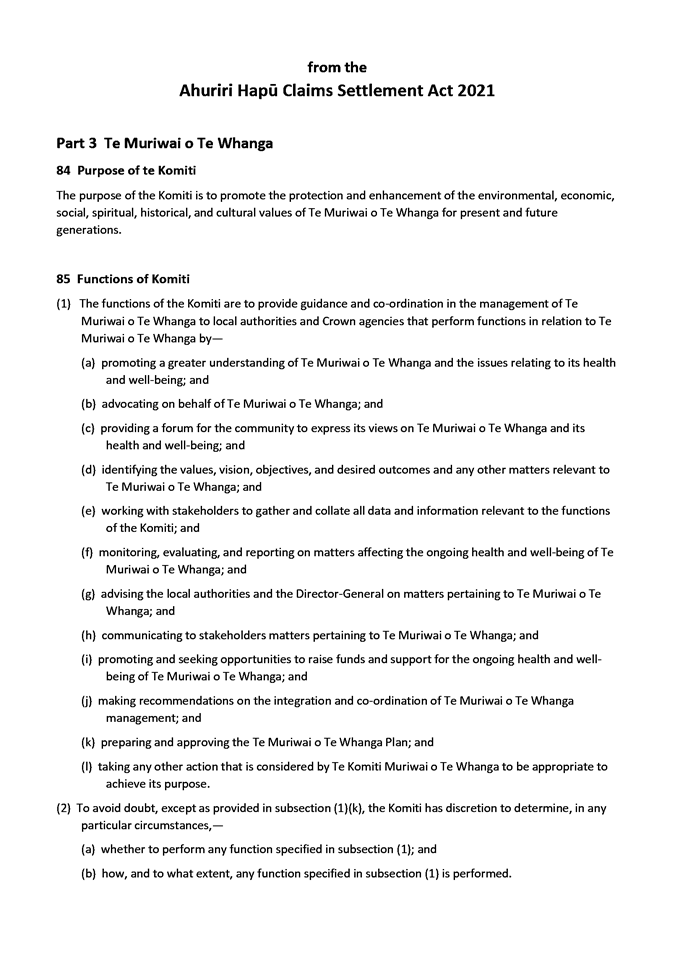
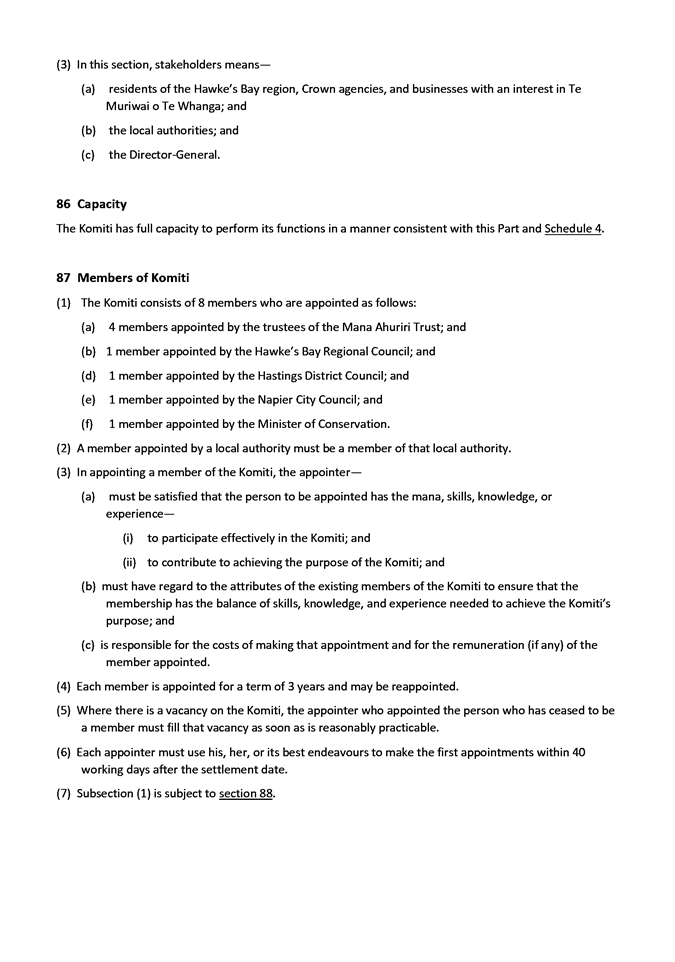
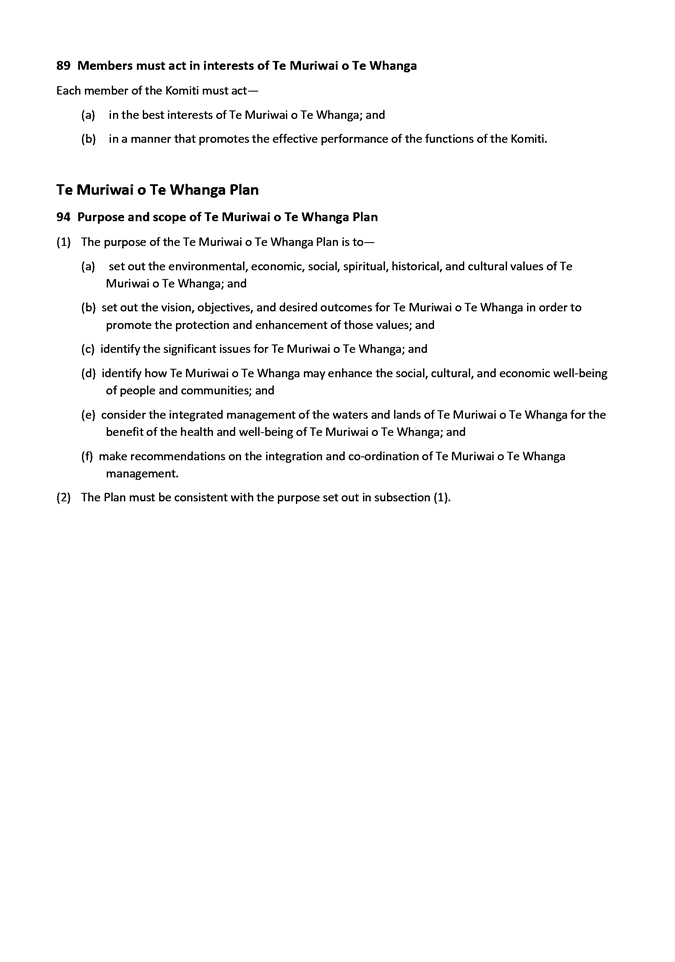
Hawke’s Bay Regional
Council
16
November 2022
Subject: Councillors'
remuneration and allowances
Reason for Report
1. This item provides the
information necessary for Council to resolve the remuneration of councillors
for the period to 30 June 2023, in accordance with the Remuneration
Authority’s 2022-23 determination.
Officers’
Recommendations
2. Staff recommend that
Council decides the remuneration rates for councillors in accordance with the
options detailed and adopts the proposed policies for reimbursement to
eligible councillors for the costs of vehicle mileage, travel time,
communications and childcare incurred in the course of undertaking their Council duties.
Executive
Summary
3. Each newly elected council
is invited to give the Remuneration Authority recommendations (by resolution)
for how its pool ($644,302) should be distributed
among all councillors except the Chair. The resolutions will include a rate for
base councillor remuneration (minimum $58,224) and rates for all/any positions
of responsibility and must use the entire pool.
4. The authority will consider
the Council’s recommendations before determining the remuneration payable
to members. Once the Remuneration Authority has made its decision on
Council’s proposed remuneration, the revised remuneration levels in the
new determination will be backdated to the day after the appointments to
positions with additional duties were made.
Background
/Discussion
5. Each year the Authority
determines the remuneration and allowances available for elected members.
6. In making the
Determination, the RA does so in accordance with LGA Schedule 7 as follows.
7
Mandatory criteria for Remuneration Authority
(1)
In determining remuneration under clause
6,
the Remuneration Authority must have regard to the need to—
(a)
minimise the potential for certain types of remuneration to distort the
behaviour of the persons listed in clause
6(1)
in relation to their positions as listed in clause 6(1); and
(b)
achieve and maintain fair relativity with the levels of remuneration received
elsewhere; and
(c) be fair both—
(i) to the persons whose remuneration
is being determined; and
(ii)
to ratepayers; and
(d)
attract and retain competent persons.
(2)
The criteria in subclause (1) do not prevent the Remuneration Authority from
determining allowances additional to salary for attending meetings.
7. Having conducted a review,
including extensive consultation, of how elected members’ remuneration is
calculated, the Remuneration Authority has introduced, for this term, a revised
and updated Council size index used to calculate each council’s
remuneration pool and Chair/ Mayor salary.
Elected
Member Remuneration
8. Previously, Council has
paid higher remuneration ($8,000-10,000 per year more) to those councillors
fulfilling positions with additional duties, including:
8.1. Deputy Chair of Council
8.2. Corporate and Strategic
Committee Chair
8.3. Finance, Audit and Risk
Sub-committee Chair
8.4. Environment and Integrated
Catchments Committee Chair
8.5. Regional Transport
Committee Chair
8.6. Hearings Committee Chair
8.7. Clifton to Tangoio Coastal
Hazards Strategy Joint Committee Chair.
9. Payments for additional
duties apply to all the positions that a member holds. For example, if
the Deputy Chair also chairs a Committee, only one additional payment is made
to cover all the duties.
10. For removal of doubt, participation on
Joint committees and outside bodies as a Council representative has not
previously been considered for additional remuneration.
11. In the interests of transparency, the
remuneration for the Chairperson of Council has been set by the Remuneration
Authority at $142,761. The Chair’s
salary will be reduced to offset private use of the Council-provided vehicle as
agreed with the Chair, and calculated in accordance with Clause 9 of the
Determination.
12. The Remuneration Authority
has set the Pool for Hawke’s Bay Regional Council at $644,302 per annum
and the minimum councillor remuneration at $58,224 per annum.
Options
for consideration
13. The options staff ask councillors to
consider for distribution of the pool are structured to provide:
13.1. Option 1 - Greater equity
across councillors, e.g. higher base salary and lesser additional duties
‘top up’ including HBRC Deputy Chair at same rate as a committee
chair
13.2. Option 2 - More recognition
of leadership roles, e.g. base salary same as set by RA and higher additional
duties pay for committee chairs and HBRC Deputy Chair
13.3. Option 3 – mid-way
between options 1 and 2.
Scenario
1
14. Based on 6 positions of added
responsibility for:
14.1. Deputy Chair of Council
14.2. Corporate and Strategic
Committee Chair
14.3. Audit and Risk Committee
Chair
14.4. Environment and Integrated
Catchments Committee Chair
14.5. Regional Transport
Committee Chair
14.6. Hearings Committee Chair
15. This scenario assumes that:
15.1. HBRC chair and deputy chair will be
the RPC co-chair and deputy co-chair
15.2. Māori Committee chair will be a
Taiwhenua member, not a councillor.
|
Total
Remuneration Pool = $644,302
|
|
Option
1
|
Option
2
|
Option
3
|
|
Base
salary $61,000 pa
|
Base
salary $58,224pa
|
Base
salary $60,000 pa
|
|
Deputy
Chair $66,717
pa
|
Deputy
Chair $68,567
pa
|
Deputy
Chair $67,384
pa
|
|
Committee
Chair $66,717 pa
|
Committee
Chair $68,567 pa
|
Committee
Chair $67,384 pa
|
Scenario 2
16. Based on 7 positions of added
responsibility for:
16.1. Deputy Chair of Council
16.2. Corporate and Strategic
Committee Chair
16.3. Audit and Risk Committee
Chair
16.4. Environment and Integrated
Catchments Committee Chair
16.5. Regional Transport
Committee Chair
16.6. Hearings Committee Chair
16.7. Māori Committee Chair or
RPC Co-chair not HBRC Chair
17. This scenario assumes that either the
Māori Committee chair will be a councillor or the RPC Co-chair will be a
councillor other than the HBRC chair or deputy.
|
Total
Remuneration Pool = $644,302
|
|
Option
1
|
Option
2
|
Option
3
|
|
Base
salary $61,000 pa
|
Base
salary $58,224pa
|
Base
salary $59,500 pa
|
|
Deputy
Chair $65,900
pa
|
Deputy
Chair $67,090
pa
|
Deputy
Chair $66,543
pa
|
|
Committee
Chair $65,900 pa
|
Committee
Chair $67,090 pa
|
Committee
Chair $66,543 pa
|
18. Both scenarios have been calculated
using the same ‘additional’ amount for all committee chairs and
Council’s deputy chair.
19. The Remuneration Authority
has provided a spreadsheet that Council staff are required to use, which
calculates the remuneration levels in a way that ensures the entire
remuneration pool is allocated. In addition to the spreadsheet Council’s
proposal to the RA must include brief descriptions of each position of
responsibility including the additional responsibilities over and above the
base councillor role which covers duties, delegations, reporting obligations
and the extra time involved in carrying out the additional responsibilities.
Elected
Member Allowances and Expenses
20. The determination linked to
this item sets out the details and conditions or criteria relating to the
payment of vehicle mileage (section 11), travel time (section 12),
communication (section 13) and childcare allowances (section 14). The terms,
conditions and amounts included in the determination apply for the period up to
30 June 2023.
21. As a way of encouraging
sustainable transport options some councils pay travel allowances for travel by
public transport, micromobility vehicles (e-bikes and e-scooters) and bicycle.
To consider whether to offer the payment of vehicle mileage for travel by
e-bike, councillors are referred to the attached NZ Analysis of e-bike costs
and advised that this is a matter of discretion for Council as neither Inland
Revenue nor the Remuneration Authority have prescribed a
reimbursement rate.
22. The following Communication
(ICT) allowances are paid to
eligible elected members
to assist with the costs
of equipment and technology
provided by the elected member. Where Council requires members to use the
following equipment the allowances below will be paid.
|
Item
|
Annual Allowance
|
|
Use of a mobile phone
|
$200
|
|
Mobile phone services
|
$500
|
|
Internet services
|
$800
|
|
Use of a printer
|
$50
|
|
TOTAL
|
$1550 pa
|
22.1. Elected Members will be
limited to a total payment of $1,550
per annum.
22.2. All equipment provided by
the Council continues to be the property of the Council.
22.3. Elected members have the
option to have a Council mobile phone on the HBRC monthly monthly mobile phone
plan. If elected members take up this option, the associated allowances ($700)
will not be paid.
23. In considering whether to
offer the Childcare Allowance to eligible members, staff ask councillors to:
23.1. consider circumstances
where childcare allowances may be required to enable elected members to
undertake their duties, rather than focus on specific individuals
23.2. Childcare allowances can be
incurred by elected members at most times of a 24/7 weekly period, but most
probably, would be applicable for daycare fees to allow meeting attendance,
babysitting fees to allow attendance at night meetings, or casual payments for
the likes of holiday programmes to enable elected members to attend meetings
during those periods
23.3. The cost of childcare
allowance is met from outside the governance remuneration pool available to
elected members, thus requires Council to budget for this item specifically.
Whilst very difficult to calculate what an annual cost to Council for
acknowledging this Clause in the determination may be, staff suggest a budget
in the vicinity of $20-25,000 would be sufficient depending upon the number of
councillors who require this support.
24. Staff propose that Council
agrees that the allowances paid to eligible councillors, in accordance with the
Remuneration Authority’s Determination, are as set out in the following
table.
|
Allowance
|
15 October 2022 – 30 June 2023
|
|
Mileage Allowance – petrol or diesel
|
$0.83
per km (first 14,000 km)
|
|
Mileage
Allowance - Hybrid
|
$0.83
per km (first 14,000 km)
|
|
Mileage
Allowance – Electric Vehicle
|
$0.83
per km (first 14,000 km)
|
|
Mileage
Allowance – E-bike
|
$0.28
per km (first 14,000 km)
|
|
Mileage
Allowance (after first 14,000 km)
|
$0.31/km
petrol/diesel
$0.18/km
hybrid
$0.10/km
electric including e-bike
|
|
Threshold
time on daily travel
|
8
hours in a 24 hour period
|
|
Travel Time Allowances
|
$40
per hour (after the first hour of eligible travel)
|
|
Communication
(ICT) Allowance
|
Limited
to $1,550 per year
|
|
Childcare
Allowance
|
Limited
to $6,000 per child per year
|
25. The Council’s Elected Members’
Expenses and Allowances
Policy will be updated to reflect
the decisions (resolutions) of Council and provided to the Remuneration
Authority for consideration along with the remuneration proposal.
Financial
and Resource Implications
26. Council and its committees
are required to make every decision in accordance with the requirements of the
Local Government Act 2002 (the Act). Staff have assessed the requirements in
relation to this item and have concluded that because the payment of
councillors’ remuneration and allowances is prescribed by Schedule 7 of
the Act the
decision-making provisions do not apply.
Decision Making Process
27. Council and its committees
are required to make every decision in accordance with the requirements of the
Local Government Act 2002 (the Act). Staff have assessed the requirements in
relation to this item and have concluded:
27.1. The decision does not
significantly alter the service provision or affect a strategic asset, nor is
it inconsistent with an existing policy or plan.
27.2. The use of the special
consultative procedure is not prescribed by legislation.
27.3. The decision is not
significant under the criteria contained in Council’s adopted
Significance and Engagement Policy.
27.4. The persons affected by
this decision are elected members.
27.5. Given the nature and
significance of the decisions, and also the persons likely to be affected by or
have an interest in the decisions made, Council can exercise its discretion and
make these without consulting directly with the community.
Recommendations
That Hawke’s Bay Regional
Council:
1. Receives and considers the Councillors'
remuneration and allowances staff report.
2. Agrees that the decisions
to be made are not significant under the criteria contained in Council’s
adopted Significance and Engagement Policy, and that Council can exercise its
discretion and make the required decisions without conferring directly with the
community.
3. Resolves that the
remuneration levels to be paid to elected members, in accordance with the Local
Government Members (2022/23) Determination 2022 are as follows.
3.1. $____ per annum for a councillor
with no additional responsibilities
3.2. $____ per annum for each position of
additional responsibility being:
3.2.1. _________________
3.2.2. _________________
3.2.3. _________________
3.2.4. _________________.
3.2.5. _________________
3.2.6. _________________
4. Agrees to that the allowances paid to
eligible councillors, in accordance with the Remuneration Authority’s
Determination and the criteria set therein, are:
|
Allowance
|
15 October 2022 – 30 June 2023
|
|
Mileage Allowance – petrol or diesel
|
$0.83
per km (first 14,000 km)
|
|
Mileage
Allowance - Hybrid
|
$0.83
per km (first 14,000 km)
|
|
Mileage
Allowance – Electric Vehicle
|
$0.83
per km (first 14,000 km)
|
|
Mileage
Allowance – E-bike
|
$0.28
per km (first 14,000 km)
|
|
Mileage
Allowance (after first 14,000 km)
|
$0.31/km
petrol/diesel
$0.18/km
hybrid
$0.10/km
electric including e-bike
|
|
Threshold
time on daily travel
|
8
hours in a 24 hour period
|
|
Travel Time Allowances
|
$40
per hour (after the first hour of eligible travel)
|
|
Communication
(ICT) Allowance
|
Limited
to $1,550 per year
|
|
Childcare
Allowance
|
Limited
to $6,000 per child per year
|
5. Adopts the HBRC
2022-2023 Elected
Members’ Expenses and Allowances Policy as updated to incorporate the
decisions made today and subject to confirmation by the Remuneration Authority.
Authored by:
|
Leeanne Hooper
Team Leader Governance
|
|
Approved by:
|
James Palmer
Chief Executive
|
|
Attachment/s
|
1⇩
|
proposed 2022-2023 Elected Members
Expenses and Allowances Policy
|
|
|
|
2⇩
|
NZ analysis of e-bike costs
|
|
|
|
proposed 2022-2023 Elected Members
Expenses and Allowances Policy
|
Attachment
1
|
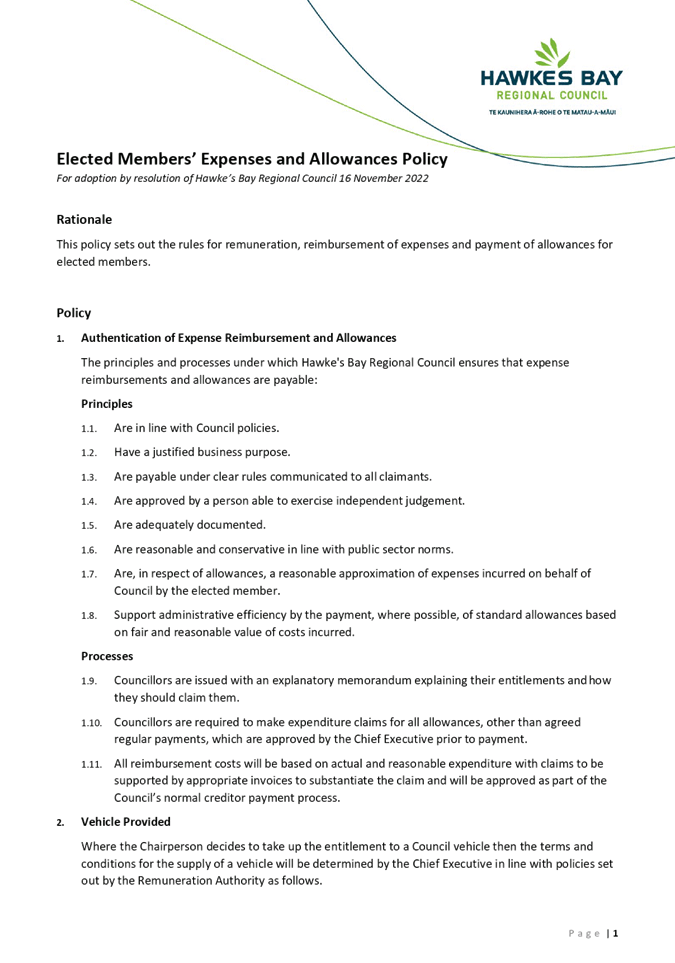
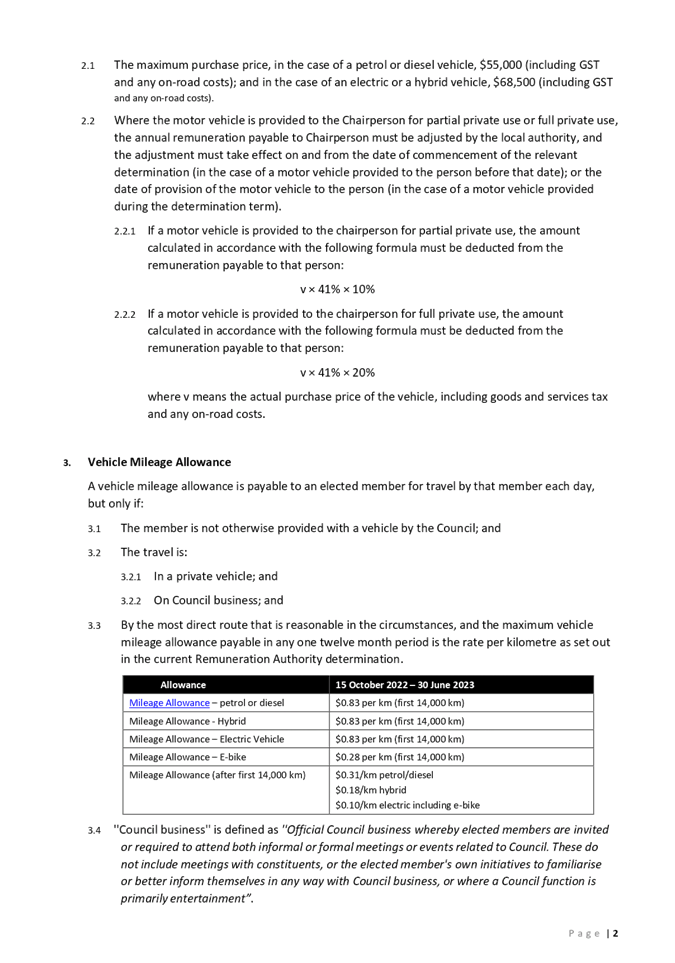
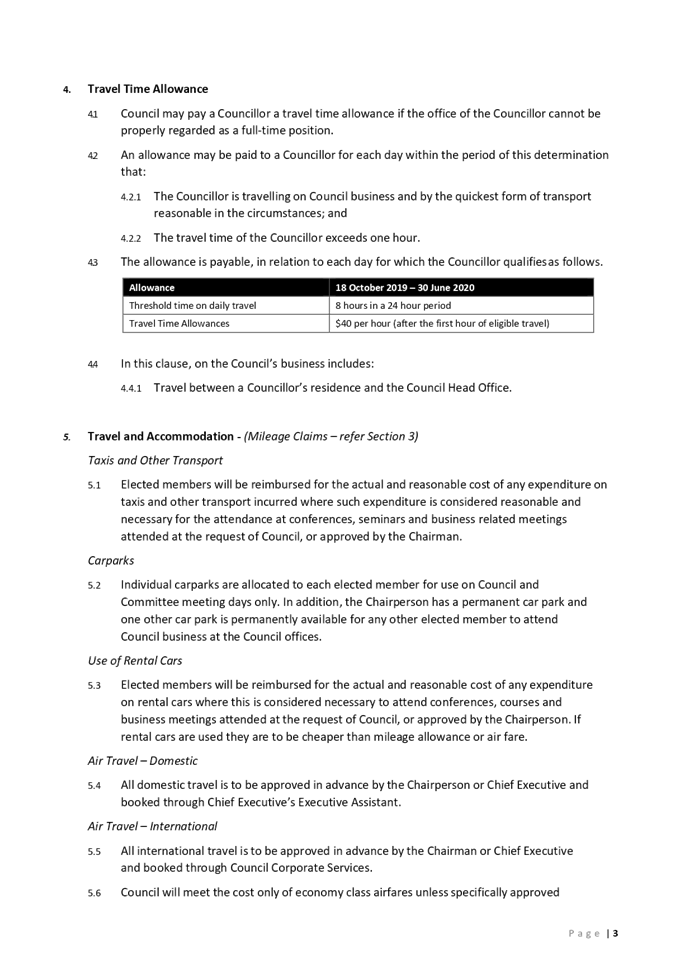
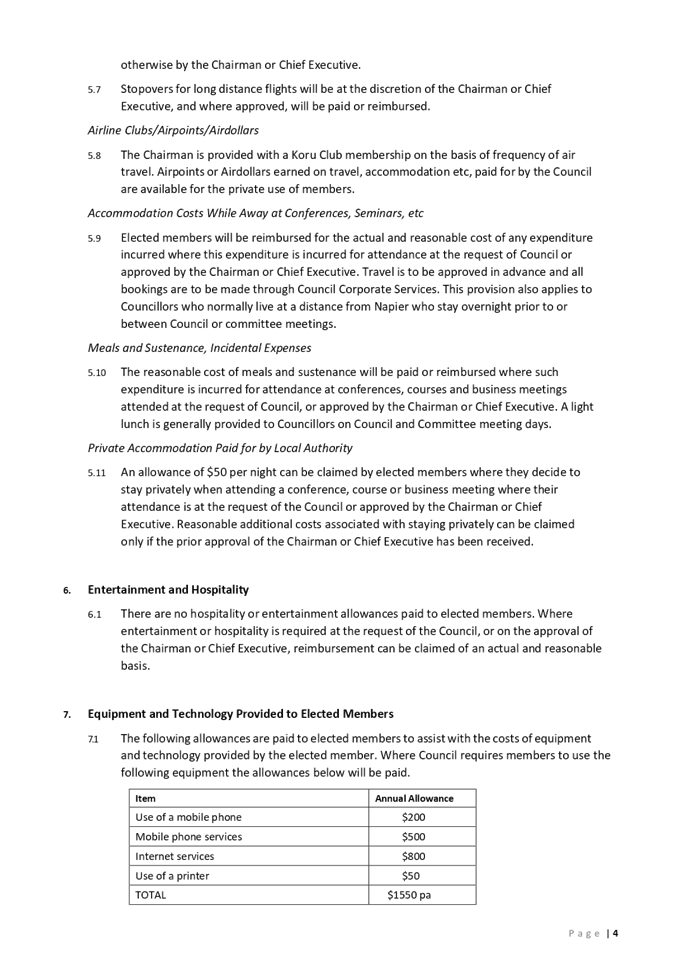
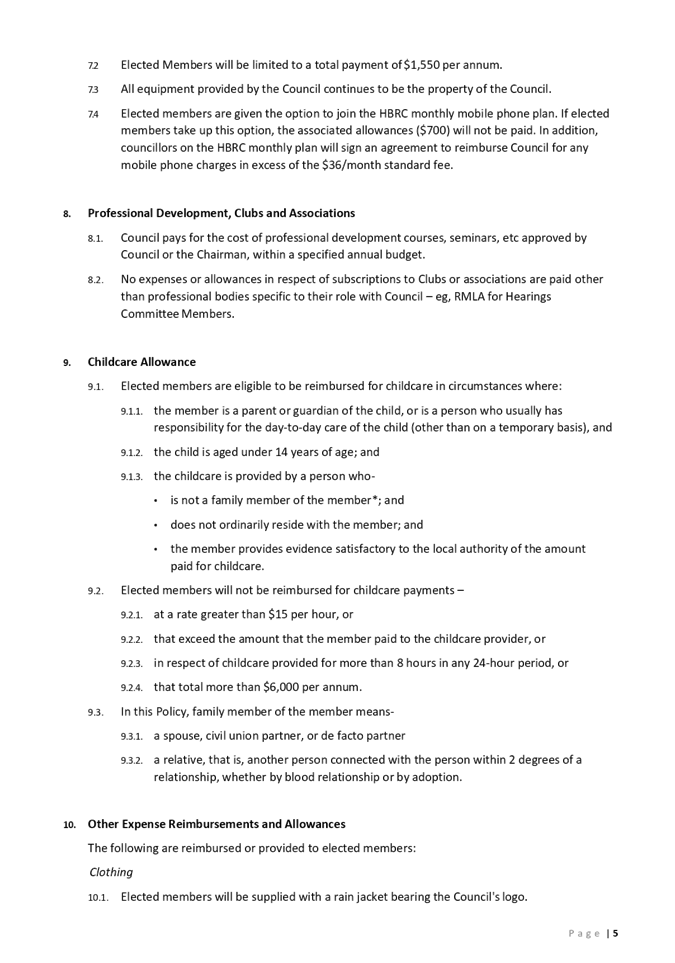

|
NZ analysis of e-bike costs
|
Attachment
2
|
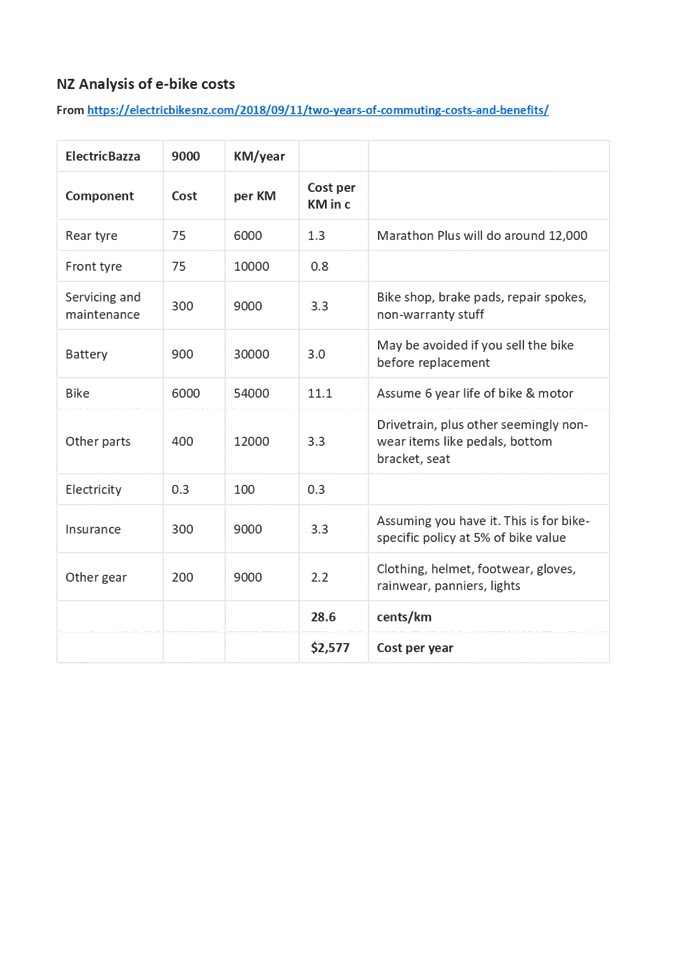
HAWKE’S
BAY REGIONAL COUNCIL
16
November 2022
Subject: Proxy for the HBRIC Ltd
Annual General Meeting
Reason for Report
1. This item provides the
means for Council to appoint a proxy and alternate, to vote at the Annual
General Meeting of Hawke’s Bay Regional Investment Company Limited (HBRIC
Ltd).
Executive
Summary
2. HBRIC Ltd intends to hold
its Annual General Meeting at 9.30am on Tuesday, 22 November 2022 at the
offices of Moore Markhams, 308 Queen Street, Hastings. The Council (as
the shareholder) is required to appoint a proxy and alternate to attend this meeting
and vote on the Council’s behalf at the meeting.
3. There are 2 items that
require shareholder voting, being:
3.1. To receive the
company’s Financial Statements for the year ended 30 June 2022
3.2. To note the appointment of
Auditors.
4. All Councillors are invited
to the Annual General Meeting. A copy of the Notice of
the Annual General Meeting of HBRIC Ltd is attached.
5. With regards to appointing
a proxy to attend this meeting, it is recommended that the proxy be given to
the Deputy Chairman of the Council, with the alternate being the Chief
Executive of the Council.
Decision Making Process
6. Council and its committees
are required to make every decision in accordance with the requirements of the
Local Government Act 2002 (the Act). Staff have assessed the requirements in
relation to this item and have concluded:
6.1. The decision does not
significantly alter the service provision or affect a strategic asset, nor is
it inconsistent with an existing policy or plan.
6.2. The use of the special consultative
procedure is not prescribed by legislation.
6.3. The decision is not
significant under the criteria contained in Council’s adopted
Significance and Engagement Policy.
6.4. The decisions in relation
to the HBRIC Ltd Annual
General Meeting are required under the Companies Act 1993.
Recommendations
That Hawke’s Bay Regional
Council:
1. Receives and considers the
“Proxy for the HBRIC Ltd Annual General Meeting” staff report.
2. Agrees that the decisions
to be made are not significant under the criteria contained in Council’s
adopted Significance and Engagement Policy, and that Council can exercise its
discretion and make decisions on this issue without conferring directly with
the community or persons likely to have an interest in the decision.
3. Notes the date of the
Hawke’s Bay Regional Investment Company Limited Annual General Meeting is
9.30am on 22 November 2022.
4. Appoints _________________
to act as Council’s proxy at the Annual General Meeting of the
Hawke’s Bay Regional Investment Company Limited to be held at 9.30am on
Tuesday 22 November 2022, and to vote as proxy holder on behalf of the
Council.
5. Appoints _________________
to act as Council’s alternate.
Authored by:
|
Tom Skerman
HBRIC Commercial Manager
|
|
Approved by:
|
Susie Young
Group Manager Corporate Services
|
|
Attachment/s
|
1⇩
|
HBRIC Notification of AGM November
2022
|
|
|
|
HBRIC Notification of AGM November 2022
|
Attachment
1
|
